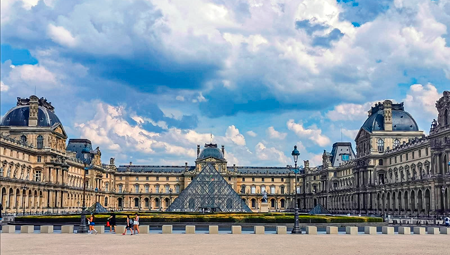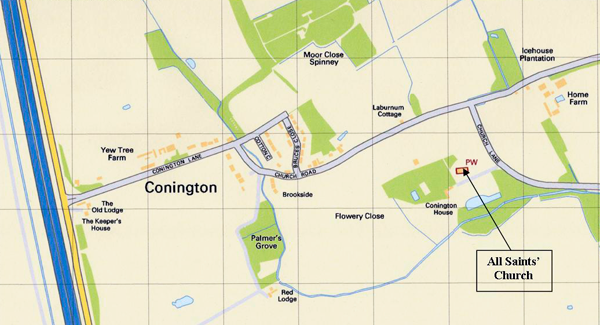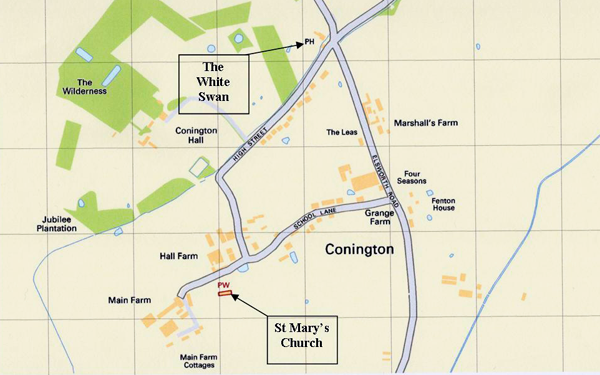
 The
Musings of a Monuments Man
The
Musings of a Monuments ManPosted 28th February 2021: The Key and the Stone Beware the Organ Tuner! Psst, Want Some Lead, Guv? Bats in the Belfy What's the Difference between a Cathedral and a Museum? Conington or Conington
Posted 7th March 2021 : Locked and Barred Tales of Three Locked Churches (The PeepToe Mail; The Pretty Girl Holds the Key; Private Property: Keep Out!) No Reply?
Posted 15th March 2021 Praise to the Postie We Shall Have Music Wherever We Go Seeing a Saw Horse
Posted 24th March 2021: Tales of Three More Locked Churches (The Never Open Door; Locked In; Wot, No Vicar) Bequests The Watch That Ran Backwards
Posted 9th May 2021: How to Set Off Alarms! Tales of a Another Three Locked Churches (Sling Your Hook; Digi-Tramps and Dog Walkers; No Way In)
Posted 1st March 2022: Excitement! Tales of a Further Three Locked Churches (A Lucky Find; Church: What Church? Best Viewed from Outside) A Strange Hotel Not Strictly
Wot, No Church? Roads, Maps and Road Maps Tales of Three Yet More Locked Churches (The Church & The Mairie 1, The Church & The Mairie 2, The Church & The Tourist Office)
To while away the hours during this virtual house arrest imposed upon us by those attempting to fight the Covid Pandemic and when I cannot visit churches to take photographs and none have been sent me me recently, I have begun this blog to amuse myself and hopefully others. Some of these items do appear elsewhere on this site but I thought might fun to gather them together and expand them a little on one page. Other items are new and more will be added later.
I am asked from time to time why do I drive around taking photographs of church monuments; why didn't I photograph those subjects that appear in photographic magazines such as landcapes, sport, wildlife, pets, flowers, portraits or children. You might win a prize too! Some of these are excellent from both the esthetic and technical points of view but they simply do not hold any great interest to me. Architecture might be an interesting subject to pursue particularly industrial architecture, street photography too but I do not have the skill nor the Leica of Henri Cartier-Bresson, and surrealism (my favourite art form) if only I knew where to start!
Hunting church monuments takes us to some interesting and beautiful villages, towns and cities which otherwise we would never have visited; there have been one or two not so pleasant ones from time to time but these are very rare. St Albans is a very fine small city that comes to mind, unspoiled by brash shop fronts and the almost inevitable 'chains', Wingfield in Suffolk, Pamber Prior in Hampshire, Framlingham in Norfolk, Bures in Suffolk (church and chapel), Aldworth in Berkshire with a fascinating collection of effigies in the church and the best pub so far, and Catterick in North Yorkshire which has the best chip shop we have discovered to date. If nothing else I am an expert on chip shops. Our daughter lives near Ely, a small city with free parking, a useful raiway station, good pubs, and those rare things: art shops and independent bookshops which are among the best too; and then there's the Cathedral, so empty your piggy bank! But there is one pub to challenge that at Aldworth and that is the Holly Bush in Potter's Crouch: I do not know if there is a church with fine monuments or even a church but this is a pub I would go on a hundred mile tour to visit. Unfortunatley the land lord has recently moved so I hope the standards he set remain in place.
One of the delights of English villages - which I regret to say French villages do not share - is as well as a church there is always a pub nearby, and often a very fine one serving the best of English 'pub grub' and the best real ale. I really enjoy the simple - and often the most reasonably priced - French cuisine with a glass of Southern French red wine, but I look forward to these tit-for-tat restrictions being lifted so we can cross the Channel and enjoy a pint of Old Peculiar with steak and kidney pie, proper chips and mushy peas (no other veg). Some villages have hardly anything but a church and a pub and I remember 'up north' pubs were often next to churches in industrial towns and were dubbed 'churches with chimneys': worshippers began their day in the one and then sojourn to the other for different sort of spiritual refreshment.
We meet some delightful and interesting people on our trips often, but not always, connected with the churches we are visiting. I used to meet many vicars and rectors some years ago but this is rare now with the introduction of team ministries where the lead cleric is known (although it might be said historically incorrectly) as the Team Rector. I now more often deal with administrators, parish clerks, churchwardens, and other lay folk. However I recently wrote to a vicar in Suffolk asking permission to visit and photograph in his church and his friendly reply also recommended The de la Pole Arms opposite the church for lunch, adding that we might have to book on 'Fish Friday'. The church was one of the most interesting with an excellent series of monuments and so was the de la Pole Arms who provided superb pub grub and real ale. In fact we returned a few months later with our grandchildren and met the Vicar quite by chance in the pub, a delightful and friendly man indeed.
So here we go at my first attempt at blogging. Any thoughts, ideas, comments and moans are welcome, moans less so, of course.
| The Key and the Stone |
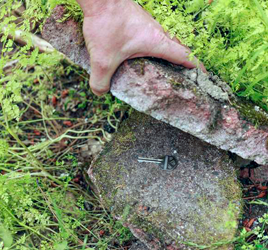 Years ago, long before the internet or even personal computers, I
wrote to the 'Vicar or Rector', as I would at that
time, of a church in
Hampshire, asking permission to visit the church and take
photographs of the monuments. What I did not know was that the
church in question no longer served a parish so there was
neither vicar nor rector any more, it
being, what was then rather tactlessly known as, 'redundant'.
Incidentally such churches, which are still used at times for
worship, were cared for by the Redundant Churches Fund
which in 1994 changed its name to the more polite Churches
Conservation Trust. But the absence of a vicar was no problem as the ever resourceful
Post Office
delivered my letter to the person who acted as key holder of this
church. I was later to find many times that the Post Office and the
wonderful postmen and women have far more intelligence and
ability than the internet with all its fine resources. The caretaker
then
replied and asked me to telephone him to arranged an appointment to visit his house and collect
the church key. I did so and he told me that if I arrived at 10.00 am on the day
arranged I would find the key under a large stone on his door
step.
Years ago, long before the internet or even personal computers, I
wrote to the 'Vicar or Rector', as I would at that
time, of a church in
Hampshire, asking permission to visit the church and take
photographs of the monuments. What I did not know was that the
church in question no longer served a parish so there was
neither vicar nor rector any more, it
being, what was then rather tactlessly known as, 'redundant'.
Incidentally such churches, which are still used at times for
worship, were cared for by the Redundant Churches Fund
which in 1994 changed its name to the more polite Churches
Conservation Trust. But the absence of a vicar was no problem as the ever resourceful
Post Office
delivered my letter to the person who acted as key holder of this
church. I was later to find many times that the Post Office and the
wonderful postmen and women have far more intelligence and
ability than the internet with all its fine resources. The caretaker
then
replied and asked me to telephone him to arranged an appointment to visit his house and collect
the church key. I did so and he told me that if I arrived at 10.00 am on the day
arranged I would find the key under a large stone on his door
step.I always arrive early and this day was no exception: It must have been around 9.30 am or so. I stopped outside the house and there was the stone on the door step. I walked up the short drive only to find there was no key under the stone; I knocked on the door only to received no answer. I sat in my car but nobody arrived at the house and the door never opened. At 10.01am I retraced my steps along the drive, lifted the stone and there was the key. Perhaps someone knows something that I do not! The church, by the way, was quite a small one and across a muddy field; if there was a drive either I did not find it or it had become obliterated with time. The tomb was very large and nearly filled the chancel. I returned the key through the letterbox as requested and drove home. I can no longer accurately remember the key holder's name: it may have been Dumbledore, Merlin or something like that. |
| Beware the Organ Tuner! | |
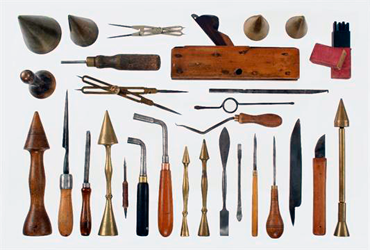 Tea with the vicar is rare these days but years ago,
when I began visiting churches, I was occasionally invited into
the vicarage for a cuppa. I wrote
to a vicar in Hampshire with my usual request and he replied asking me
to called at his house for a cup of tea before Tea with the vicar is rare these days but years ago,
when I began visiting churches, I was occasionally invited into
the vicarage for a cuppa. I wrote
to a vicar in Hampshire with my usual request and he replied asking me
to called at his house for a cup of tea before visiting the
church. Actually, these short visits are a very tactful and
polite way of assessing those who wish to visit the church; and in this case, as will be seen,
it was not without good reason. The Vicar told me that his church
had been robbed recently and there had been a number of
similar robberies in
other churches in the area. He then told me, with both delight
and some surprise, that all of the items taken from the
churches had been recovered and returned. It seems that the
person who had stolen them had not done so for any real personal gain
by somehow selling them himself or to a receiver of stolen goods; the
latter, from past experience, are often 'respectable' second hand book dealers or antique
dealers, who clearly do not ask the questions they ought to ask
and freely display the goods in their shops. Rather this
particular thief actually collected church artifacts,
just as people collect stamps, coins, vinyl records, cheese
labels, cigarette cards, slide rules and just about anything,
even things which can hardly be conceived as being collectable.
I once visited a house of a lady who collected vintage prams:
the house was somewhat difficult to walk around.
visiting the
church. Actually, these short visits are a very tactful and
polite way of assessing those who wish to visit the church; and in this case, as will be seen,
it was not without good reason. The Vicar told me that his church
had been robbed recently and there had been a number of
similar robberies in
other churches in the area. He then told me, with both delight
and some surprise, that all of the items taken from the
churches had been recovered and returned. It seems that the
person who had stolen them had not done so for any real personal gain
by somehow selling them himself or to a receiver of stolen goods; the
latter, from past experience, are often 'respectable' second hand book dealers or antique
dealers, who clearly do not ask the questions they ought to ask
and freely display the goods in their shops. Rather this
particular thief actually collected church artifacts,
just as people collect stamps, coins, vinyl records, cheese
labels, cigarette cards, slide rules and just about anything,
even things which can hardly be conceived as being collectable.
I once visited a house of a lady who collected vintage prams:
the house was somewhat difficult to walk around.And the person who collected these items did so very easily as he was regularly given the church key, had plenty of time to spare, could park a van outside without questions being asked, and had every right and reason to be in the church as much as the lady who arranged the flowers: he was the organ tuner!
|
| Psst, Want Some Lead, Guv? |
 When I was quite
young - certainly less than eleven - a friend and
I decided to
become junior rag and bone men: we would knock on front doors
and ask whoever appeared if they had any jam jars. We would
collect quite a number and when we could carry no more, we
would go along to 'Suggie's Yard', the premises of the local
scrap dealer, and sell them for a few pennies, maybe even a
shilling or two, especially if we managed to find some lead as
well.
We indeed did collect lead, although I can no longer recall from
where: we probably found it lying about in one of the many
derelict houses we used to explore, on waste land we combed, or
even by excavating the local rubbish tips. Yes we were junior
'golden dustmen' or rather 'leaden ones'! I have to stress we never removed it
from the church roof, but others, it seems, clearly have more
courage and less conscience. When I was quite
young - certainly less than eleven - a friend and
I decided to
become junior rag and bone men: we would knock on front doors
and ask whoever appeared if they had any jam jars. We would
collect quite a number and when we could carry no more, we
would go along to 'Suggie's Yard', the premises of the local
scrap dealer, and sell them for a few pennies, maybe even a
shilling or two, especially if we managed to find some lead as
well.
We indeed did collect lead, although I can no longer recall from
where: we probably found it lying about in one of the many
derelict houses we used to explore, on waste land we combed, or
even by excavating the local rubbish tips. Yes we were junior
'golden dustmen' or rather 'leaden ones'! I have to stress we never removed it
from the church roof, but others, it seems, clearly have more
courage and less conscience.I visited a church in Berkshire some years ago now where the Vicar apologized for the state of the church, telling me that they had just had the lead stolen from the roof and that this was the second occurance within months: so hence the cold and damp state of the church interior. The cheek and the challenge of removing lead from a church roof is really quite astounding: church roofs are very high, often covering a large area and, although lead is a very soft metal and relatively easily rolled, it is also very heavy indeed. How do these people get onto the roof in the first place and then lower the rolls of lead onto the ground without being spotted? How do they manage to carry out their work and not be heard? This is hardly a quick, casual theft: it must be carried out by organized gangs with ladders and lorries. They presumably carry out their work at night so must use lights and probably fairly powerful ones too. To whom do they sell the lead? I find it quite amazing that they are rarely discovered and apprehended. Our local church in Devon did not have its lead removed but during the day of one Christmas Eve, its oil tank was emptied as were those of several houses in the area who used oil fired central heating. Parishioners were told to arrive well wrapped and were issued with blankets for the Midnight Service on this Christmas Eve. This wasn't someone with a jerry can opening a tap: this again was a gang with an oil tank lorry and the equipment to pump out the oil. Again were these thieves were never spotted or challenged? Where were the Devon and Cornwall police or neighbourhood watch? Churches do have their spies, and I am glad that they do, so it is amazing that the above can ever happen, especially in daylight hours. I went into a church in a small village in Devon to draw a double effigy. It's an interesting church with a very tall thin tower, which may be seen for miles around, as well as there being a number of interesting monuments. The church is is in the centre of the village and when I had finished my drawing I went for a cup of coffee and a snack in a small café , which was attached to a shop directly opposite the church. The proprieter, who served me, told me that he had seen me going into the church but not coming out again, so was just going to see if I were all right. Actually he really meant 'if I were up to no good!' His tact was superb and he did not ask to carry out a bag search! We are lucky that people do keep an eye on our churches but even if no one specifically does, does no one observe anything unusual? So it is quite amazing that a church can have its lead roof stripped and a oil tank lorry can arrive and pump out the heating oil from the tank during the day and nobody observes it. |
| Bats in the Belfry (In More Senses Than One!) |
 A few years ago we visited a church in Bedfordshire where we were met by the Vicar, a very friendly and helpful man, who let us into the church, rather curiously, via a locked door leading into the vestry and then through another door into the chancel. The chancel was screened off from the nave by a large heavy duty, clear plastic sheet closed with a zipper which could be opened to enter the nave. All the monuments, pews, lectern, pulpit and other furnishings were covered in thick protective sheets. The Vicar explained that the church had become infested with bats and that, as we knew, bats were a protected species and could not be eliminated or evicted. Bat excrement causes erosion of stonework and spreads disease to human beings (including the Covid virus and rabies) and hence, in this case, all the vulnerable surfaces were covered and services thus had to be held in the chancel where the bats had not and now could not enter. The Vicar allowed us to remove the coverings and take photographs and then left us alone, saying that it did not matter about the vestry door being left unlocked as he would return later in the day to lock it himself. We did find a suitable box, unfortunately unlocked, to give a well deserved 'offering'. An even more severe case occured somewhere in Yorkshire but I only have second hand knowledge of this. Here the church had become so infested that people had actually become ill owing to the bat excrement and services could no longer be held at all anywhere in the church. Services were now held in the church hall instead. I cannot help but think it is nonsense that people should be driven out a church where their ancestors had worshipped for centuries because of wild animals or rather by the absurd laws protecting them. There is considerable more concern about our environment in recent years and rightly so: I am sure no one would like to experience air you could taste and sometimes could hardly see though and rivers full of filth rather than fish which I recall as a young child. But we must get the balance right between the environment and the people in it. There are many, often give the title of 'environmental activists', who push this balance far too far in the wrong direction. Bats are interesting, fascinating creatures, the only flying mammals now around, and I certainly would not like to see them become extinct. But we cannot drive people out of their churches because bats have taken up residence: they can - and will - always find an alternate home elsewhere; or one can be provided nearby with bat boxes in trees. |
|
What's the
Difference between a Cathedral and a Museum? Answer: Museums are
Free! |
||
|
That 'joke' is not entirely fair - none of this short article actually is - as museums often have ways of making you pay, such as charging an entrance fee, which often is not a modest one, to visit special or promoted exhibitions. Museums receive grants from the Government for their upkeep while cathedrals, as well as other churches, do not; also cathedrals, especially the large, fine medieval ones we visit are very expensive indeed to maintain, whereas I should imagine that most of our museums are not. In 2013 the Minister concerned with the matter of cathedral charges replied in Parliament to a question about this very subject, stating that of the forty two English Cathedrals only nine charge an entrance fee. The information is several years out of date now and I do not know the current situation . It certainly seems to be more than this charge entrance fees and if you want to know why, read on!  The cathedrals that
do charge are: Canterbury, Coventry,
Ely, Exeter, Oxford (but they cheat by only charging to go
into the college, rather than the cathedral itself which anyway in the
college precincts), The cathedrals that
do charge are: Canterbury, Coventry,
Ely, Exeter, Oxford (but they cheat by only charging to go
into the college, rather than the cathedral itself which anyway in the
college precincts), St Paul's, Winchester, and York Minster.
Other non-cathedral churches also charge for entry: St Bartholemew the Great,
London; Holy Trinity, Stratford-on-Avon, Warwickshire; and St
George's Chapel, Windsor, although the last takes a leaf out of Oxford's
cheat book and charges to go into the castle grounds where the Chapel
is situated. Westminster Abbey (once an abbey, then a cathedral
for a short time, but now now a collegiate church) has the
dubious reputation of being the most expensive church in the
world to visit. The first thing to note about this list is that
these cathedrals are some of the 'tourist' cathedrals and the
majority are large medieval churches. The forty-two cathedrals
include those such as Blackburn, Bradford, Chelmsford,
Wakefield, and Derby, which, in all fairness it must be said,
are not generally regarded as 'tourist' cathedrals and I image
quite a few people did not realize that there are
cathedrals in some of these places. This distorts the figures by
making it appear that there is a smaller proportion that charge
than it would seem if the 'non-tourists' cathedrals were not
included. St Paul's, Winchester, and York Minster.
Other non-cathedral churches also charge for entry: St Bartholemew the Great,
London; Holy Trinity, Stratford-on-Avon, Warwickshire; and St
George's Chapel, Windsor, although the last takes a leaf out of Oxford's
cheat book and charges to go into the castle grounds where the Chapel
is situated. Westminster Abbey (once an abbey, then a cathedral
for a short time, but now now a collegiate church) has the
dubious reputation of being the most expensive church in the
world to visit. The first thing to note about this list is that
these cathedrals are some of the 'tourist' cathedrals and the
majority are large medieval churches. The forty-two cathedrals
include those such as Blackburn, Bradford, Chelmsford,
Wakefield, and Derby, which, in all fairness it must be said,
are not generally regarded as 'tourist' cathedrals and I image
quite a few people did not realize that there are
cathedrals in some of these places. This distorts the figures by
making it appear that there is a smaller proportion that charge
than it would seem if the 'non-tourists' cathedrals were not
included.I need to add to this list The Temple Church, London, although a charge is a recent change of policy and the fee is a very modest one. When I did visit the Temple Church to take photographs a while ago, they did not charge me at all: had they read the nice things I had written about them on these pages, was it because I was taking photographs, had a nice smile, or (hopefully not) because I'm a bit old? Anyway I put a little more than the £3 entrance fee in the box; perhaps they are more devious than I thought! Where are the other 'big' cathedrals that are not on the list such as Peterborough, Salisbury, Norwich, Lichfield, Durham, Ripon, and Southwell? These are the cathedrals that ask for voluntary contributions. I cannot remember any pressure being put on me to make such a contribution at Peterborough, Lichfield or Ripon and at Norwich, in particular, the request was a very polite one and the suggested fee a modest one. Sometimes the pressure on visitors is said to be rather excessive: I have heard that this is the case at Salisbury where the 'request' is quite intimidating one visitor wrote, as well as the suggested fee being a high one. So if a robed figure approaches you with bell, book and candle - pay up! I seem to remember that Southwell did have a compulsary charge and quite a low and curious one but it may well have been a voluntary one and I had not realized; there was also, rather curiously, a higher fee for photography. I thought that Tewkesbury Abbey had been omitted from the list because when I visited this fine church there appeared to be an entrance fee; had they seduced me into paying a voluntary fee perhaps? Durham Cathedral does not have a compulsary entrance fee but asks for a voluntary contribution of £5 per person and report that the average they actually receive is 32p. If visitors receive the quite unjustified unfriendly welcome that we received several years ago, I have to add that I am hardly surprised. However I understand that the situation in Durham has changed fairly recently. Quite a few people complain bitterly about these compulsory charges; some categorically refuse even to visit cathedrals that charge entrance fees. I do have some sympathy with this view. Places of worship they might be but they are still very expensive to maintain and someone must pay the bill. I think there is certainly justification to complain about the sometimes excessive charges, especially when you realize that it is per person, as well as the unpleasant pressure said to be put on visitors to make a 'voluntary' donation, which often features a suggested amount, itself sometimes quite a high one. Again there is a kinder side to these charges: some cathedrals allow free entry for certain purposes - obviously for worship but other reasons also - as well as at certain times, such as early morning and late evening. There are concessions too for children and students for example. What I do find objectionable, if not frankly insulting, comes from the website of a Cathedral whose charges are not only high but, on top of this charge, there are a number of extras too. I will not name this cathedral but at one point their website states that if you cannot afford the charges then speak to someone at the desk who will give you a sympathetic ear. Imagine anyone actually carrying out that embarrassing request. Do you have to take along a DHSS certificate, a pension book, or three years' audited accounts perhaps? Or do you just say that you are very sorry but you are poor. On the same website no one less than the Dean himself writes that it is quite free to attend services; I find this a quite extraordinary statement to make. What the Dean failed to mention is that you may not be charged on your way in but there will be a 'voluntary' charge one on your way out. Let us try to step outside this situation and put it into perspective. As I have said many people object to cathedral entrance charges, but why? Do people object to paying because a cathedral is a place of worship, which should be freely open to all, surely. But the majority of people are not visiting the cathedral primarily, if at all, to worship, but to enjoy seeing the building with all its many magnificent features: in other words, they are sightseers not worshippers. On the other hand people appear to be quite happy to pay to visit stately homes and often join, at no small cost it must be added, organizations such as the National Trust, so for members some of these places may be visited free. After all the majority of cathedrals are free to visit while I do not think you can visit any stately home free of charge. The medieval cathedrals were built effectively for all and the building design and work was overseen by a master mason, a man who had no formal education but learned his trade by experience; perhaps these cathedrals are all the better for that! However there was an element of trial and error and sometimes the buildings, or parts of them, did fall down! The tower at Ely is one example. Stately homes, on the other hand, were built for the very few to live in ease and opulence and designed by a qualified architect. Personally I would much rather visit a cathedral; in fact, I have no wish to visit stately homes at all. Think for a moment what each of them teaches you. The majority of people do not share my view which is maybe why Downton Abbey continued for at least six series (plus specials) whereas The Village and The Mill were each cut after two.
In France the situation is reversed: the museums all charge an entrance fee while the cathedrals - or at least those I have visited - do not, although there are exceptions to this general statement. Even Notre Dame in Paris, probably France's most well known cathedral, is free to enter but there are charges to visit the tower (€8.50) and the crypt (€6.00); both costs are more than covered if you buy the Paris Pass, which allows you free entry to a number of other places in Paris as well, including the Louvre. However the Paris Pass costs €130 per adult for a two day pass, so you may exhaust yourself trying to recover this cost in visiting enough places! Chartres is also free to enter as is Reims, but both charge a relatively small fee to visit certain parts of the building: the crypt and tower (Chartres) and the the treasury (Reims). The Louvre, the magnificent museum in Paris is €12 per person, but is well worth the cost. If you can tolerate the queues, you can stay all day (in fact you would need to stay more than all day to see it all) and the food on site is excellent and reasonably priced; my experience of English museum food is rather the reverse. Other than cathedrals every French church we have visited has been free and donation boxes are rare. One church, an interesting country church, was in a very poor condition, very damp and with a collapsed roof in a side room but there was no donation box anywhere to be found: I should like to have contributed €5.00 but there was nowhere to put it. Incidentally French churches are maintained by the state, mostly better than this example. The first thing that struck me about French cathedrals, and many churches, apart from their fine architecture is their wonderful height, so much higher than an English church of similar ground area; this proportion was most disturbing at first . The second thing was that they are virtually empty: it took me two days to photograph and record the monuments in Exeter Cathedral but only half an hour to record those in Cahors Cathedral. But they are not just empty of monuments, they seem to be empty of other things too: welcome desks (sometimes a euphemism for pay counters), books shops, coffee shops, and people, both clerical and lay, as well as those robed guides who abound in English cathedrals. What they do sometimes feature are beggars on the steps ascending to the principal entrance door who often kindly offer to open it for you. We haven't been to all French cathedrals: it would take some time there being rather a large number of them, but two particular examples we have visited spring to mind. St Denis is situated in a northern suburb of Paris and about six miles from the centre, so it means a ride on the Metro to a station of the same name if you stay in the city. It is not only a cathedral but was the burial place of the French kings and members of their families; I use the word was here as the large majority were ejected from the tombs during the fury against royalty during the Revolution and thrown into a common pit. Later, after the fortunately temporary restoration of the monarchy, they were 'resurrected' and buried in ten separate coffins in a charnel house in the crypt of the church; it must have been a difficult, if not impossible, task to carry this out as the remains had been buried in quicklime directly in the earth. Several churches in Paris and elsewhere were demolished during the Revolution but many of the monuments were rescued (by antiquarians not by royalists) and eventually found there way to St Denis. So, in effect, St Denis is is a museum as well as a cathedral and, as you might expect, the church is free to enter but there is a charge to visit the area where all the monuments are situated. Incidentally unlike the situation in Westminster Abbey, photography in not only allowed but quite free.  The other is the cathedral at Nantes, once the capital of Brittany which somehow found its way into Pays-de-la-Loire, and which contains the magnificent tomb of Duke François II and his wife, Margurite de Foix. Not only is the Cathedral quite free to visit, and photography free, but a platform has been built above this monument to allow photography at an excellent angle. There were some friendly guides too (no robes) to show you around the crypt, which has a magnificent exhibition of the history of the building - all free. In England sometimes, even if there is an entry fee, there are then more extras to visit the crypt, the tower, the gallery etc - more extras than buying a car years ago. 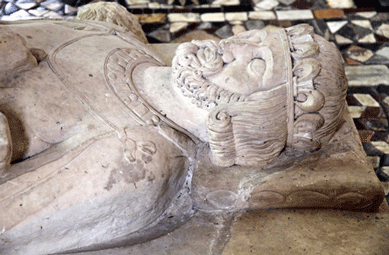 The
Abbey of Fleury at St Benoît-sur-Loire is now, once again, a real working abbey
staffed by Benedictine monks and, while not a cathedral, is a
most interesting church to visit. In the crypt there is a
reliquary containing the remains of the founder of the Order, St
Benedict himself, although this is disputed by the monks of
Monte Cassino in Italy. The church also contains the effigy of Phillippe
I, known as 'The Amourous', who died in 1108 and in whose
unusually long reign occurred both the Norman Conquest and
the First Crusade. Not only is the church free to enter but when we
visited it was open from 6.00 am until 10.00 pm; there is no
charge for photography although they politely ask you not to
take photographs during the services. This must be one of the
most welcoming churches ever. Now there's an idea: England should
perhaps undissolve the monasteries; we know where all the money
went! The
Abbey of Fleury at St Benoît-sur-Loire is now, once again, a real working abbey
staffed by Benedictine monks and, while not a cathedral, is a
most interesting church to visit. In the crypt there is a
reliquary containing the remains of the founder of the Order, St
Benedict himself, although this is disputed by the monks of
Monte Cassino in Italy. The church also contains the effigy of Phillippe
I, known as 'The Amourous', who died in 1108 and in whose
unusually long reign occurred both the Norman Conquest and
the First Crusade. Not only is the church free to enter but when we
visited it was open from 6.00 am until 10.00 pm; there is no
charge for photography although they politely ask you not to
take photographs during the services. This must be one of the
most welcoming churches ever. Now there's an idea: England should
perhaps undissolve the monasteries; we know where all the money
went! |
| Conington or Conington - or - In Praise of the Ordnance Survey |
||||||
| It may not look quite right but there is no double n in Conington; and Conington as well, for that matter. Why make it easy when you can make it difficult!
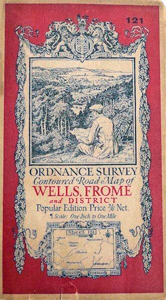 The Sat Nav has become in many cars just a
normal fixture, rather like seat belts, electric windows, radios, air
conditioning, servo-brakes, and power assisted steering. When I
bought my first car these features, if available at all, were
referred to as
extras - except of course the Sat Nav which was then a just a
dream to those, like myself, who dreamed of such things.
Sometimes I wonder how I ever managed to find new places at all without
this wonderful invention. The Sat Nav maps are not as complex and
hence nowhere near as helpful as Ordnance
Survey maps but could not serve their purpose if they were
so.
The Ordnance Survey maps are far too crowded with detailed
information for a driver to both follow and drive at the same time,
but
excellent for a passenger skilled at navigation. I also have a
hand held Sat Nav loaded with the1:50 000 Ordnance Survey maps of Britain complete
with all the, sometimes quirky, details, marking all the
churches and even indicating if it has a tower, spire, or
neither. How big is the church is not
shown. The screen is necessarily small so it can be easily held.
A few years ago in Nottinghamshire we were trying to find a
place called Owthorpe but the car's SatNav had never
heard of such a place, which has a population of less than one
hundred people. This was no problem as there it was on the
Ordnance Survey Sat Nav, located with the very extensive index;
this device does not give spoken guidance but a navigator can
use it with no difficulty.
The Sat Nav has become in many cars just a
normal fixture, rather like seat belts, electric windows, radios, air
conditioning, servo-brakes, and power assisted steering. When I
bought my first car these features, if available at all, were
referred to as
extras - except of course the Sat Nav which was then a just a
dream to those, like myself, who dreamed of such things.
Sometimes I wonder how I ever managed to find new places at all without
this wonderful invention. The Sat Nav maps are not as complex and
hence nowhere near as helpful as Ordnance
Survey maps but could not serve their purpose if they were
so.
The Ordnance Survey maps are far too crowded with detailed
information for a driver to both follow and drive at the same time,
but
excellent for a passenger skilled at navigation. I also have a
hand held Sat Nav loaded with the1:50 000 Ordnance Survey maps of Britain complete
with all the, sometimes quirky, details, marking all the
churches and even indicating if it has a tower, spire, or
neither. How big is the church is not
shown. The screen is necessarily small so it can be easily held.
A few years ago in Nottinghamshire we were trying to find a
place called Owthorpe but the car's SatNav had never
heard of such a place, which has a population of less than one
hundred people. This was no problem as there it was on the
Ordnance Survey Sat Nav, located with the very extensive index;
this device does not give spoken guidance but a navigator can
use it with no difficulty.What the standard Sat Nav map does not show are major land marks although I often think this is a feature which would be very helpful, especially in combination with an Ordnance Survey map, even if only for an extra check on position. It does show, if you care to fiddle, establishments such as Woolworths, Debenhams, C & A's and other stores but it does not show churches. Showing stores, as recent experience has shown, is not particularly helpful but showing churches certainly would be. Churches have often been in the same site for hundreds of - and sometimes over a thousand - years. I would not include every church: smaller churches and chapels would not be helpful at all for this purpose. I mean the big churches and especially those which send a tower or steeple high into the sky, and which is often the first thing you spot when you approach a village. Our daughter lives near Ely, a very attractive small city with a very attractive (and expensive to visit) cathedral whose lantern tower may be seen for miles across the flat Fenland. She also lives on the edge of several counties, some of which disappear (but sometimes reappear) or move, not literally, of course, but administratively. This causes problems when you need to find in which county a particular village is situated: what it is in is not the same as what it was in. We planned, when we visited our daughter recently, to take the two grandchildren to a church in Conington and when there for a meal at a pub called The White Swan, which I had found on the internet when searching for Conington. The White Swan received excellent recommendations so I thought this would be a good opportunity to educate the children in both the joys of visiting old churches as well as old pubs on the same day trip. The book had said that Conington was in Peterborough, presumably meaning the Soke of Peterborough rather than the actual city of that name, which I believed used to be in Northamtonshire; however the internet had said it was in Huntingdonshire. All of these aforementioned places are now in Cambridgeshire. 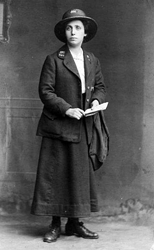 Finding Conington on the car's Sat Nav should have been a simple matter
but this turned out not to be the case as there was not one but two villages
of that name: clearly nobody had ever considered a double n Finding Conington on the car's Sat Nav should have been a simple matter
but this turned out not to be the case as there was not one but two villages
of that name: clearly nobody had ever considered a double n to
distinguish between them. One was Conington, Peterborough and
the other Conington, Cambridgeshire. Again this should have been
easy as it was clearly the Peterborough Conington we
wanted and this was easy enough to find. When we arrived,
however, there was just a number of houses arranged in a large
triangle
and nothing else: no church and no White Swan. to
distinguish between them. One was Conington, Peterborough and
the other Conington, Cambridgeshire. Again this should have been
easy as it was clearly the Peterborough Conington we
wanted and this was easy enough to find. When we arrived,
however, there was just a number of houses arranged in a large
triangle
and nothing else: no church and no White Swan.So we drove to the other Conington, a distance of some twenty miles, and there was a pub and a church even though this was an even smaller village than the earlier Conington. Unfortunately, although the pub was indeed the White Swan, the church was St Mary's rather than All Saints', the church I was looking for. So we planned to retrace our journey to the original Conington and think again. Undaunted we first visited the White Swan, where we enjoyed excellent pub grub, and then walked to the church, which proved to be unlocked and which contained a number of interesting monuments. Conington number one was, unsurprisingly, exactly the same as it had been a few hours earlier with neither pub nor church. I then thought of a brilliant idea, that is the thought was brilliant not my thinking of it or I would have thought of it earlier: look on the Ordnance Survey Sat Nav! And, sure enough, there we were marked in the centre of the village and there was the church a short drive away; we had not seen it, nor could it have been seen, from the village. This church was indeed All Saints', the correct one, but it was locked. However it was in the care of that excellent organization The Churches Conservation Trust and on the door was a notice giving the name and telephone number of the key holder; all churches should - but do not - do this. I telephoned the given number and a lady answered giving her name and address and how to find her house; this was, for once, a simple matter as the map clearly shows. The address was one of those with an A after then number and in this case it referred to the relevant door being at the side of this house while the main door was at the front. I knocked and a woman's voice from within shouted, 'Come in, it's not locked.' I went into a very small hallway with a steep stairway immediately facing me. An old lady with a stick appeared on the landing at the top of the stairs and called down to tell me the key was hanging on a rack with others just behind me and the one I wanted was the big one. She looked as if negotiating the rather steep stairs might have caused her some difficulty so she never came down, which was quite unnecessary anyway. I could hear a man's voice too at one point' so I assumed this must have been an grandparents' flat on the first floor of the family house. The lady asked me to post the key through the letter box when I have visited the church. I thanked her and left. We returned to the church, the key fitted, took quite a large number of photographs, relocked the church and returned the key. We had seen no one else.
These events teach us some lessons on what to do and take on a rural monuments hunt: 1) Never use public transport; there usually isn't any anyway. 2) Always take a 1: 50,000 Ordanance Survey map of the area (no other will do), and, if you can, a Sat Nav with O/S maps. 3) A mobile phone 4) Note book and pencil |
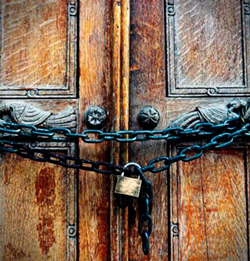 I do not like locked churches, not the churches
themselves, of course, or I would never have tried their doors in the
first place, but rather the act of keeping them locked. In fact, most churches,
both in England and in France, are not locked at all but a few are for
one reason or another. It is not just because I wish to enter to take
photographs that causes this annoyance, as I have usually (although not
always) written to the church in advance, but because many people like
to visit - need to visit - a church to pray, to meditate, to
think, or just for the peace and quiet that we all need at times in
our lives. There is no substitute. They should be open, at least during
daylight hours. We visited one church in Yorkshire some while ago only
to find it locked; I had unfortunately neglected to write to the
church in advance of our visit. There was no notice on the door or
anywhere else giving details of the key holder or the times of opening.
The was a very large sign outside announcing, 'Jesus Welcomes You!'
Had I been one of those minor vandals, armed with and skilled at
using, a spray can, I would have added below, 'But The Vicar Clearly
Does Not!'
I do not like locked churches, not the churches
themselves, of course, or I would never have tried their doors in the
first place, but rather the act of keeping them locked. In fact, most churches,
both in England and in France, are not locked at all but a few are for
one reason or another. It is not just because I wish to enter to take
photographs that causes this annoyance, as I have usually (although not
always) written to the church in advance, but because many people like
to visit - need to visit - a church to pray, to meditate, to
think, or just for the peace and quiet that we all need at times in
our lives. There is no substitute. They should be open, at least during
daylight hours. We visited one church in Yorkshire some while ago only
to find it locked; I had unfortunately neglected to write to the
church in advance of our visit. There was no notice on the door or
anywhere else giving details of the key holder or the times of opening.
The was a very large sign outside announcing, 'Jesus Welcomes You!'
Had I been one of those minor vandals, armed with and skilled at
using, a spray can, I would have added below, 'But The Vicar Clearly
Does Not!'That is another of those unfair statements as it is usually not the vicar at all (or whoever is in charge of the church) who decides whether the church be locked or not but the Parochial Church Council
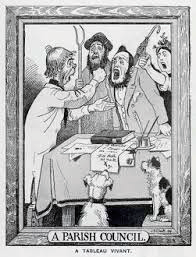 (PCC).
This is not the same as the secular Parish Council shown in the
illustration, but may function in a similar manner. I came across a good example of this in
Devon where there are four churches strung along a single country road,
one of those mostly single track, tractor infested, winding roads with high banks on
either side, which are common in the South-West peninsular and on which
you travel at your peril. Three of the churches are open but one is
locked. They constitute a joint benefice, being remote churches serving very small
villages with few parishioners. I was lucky enough to meet the vicar, a charming,
friendly lady, in one of these churches and she told me that she would
like them all to be unlocked but the PPC of the locked church insists it be
otherwise. Why? It is often because members of the PCC are sometimes of
a very conservative nature and as the church was always locked in the
past, so always locked it must remain. Curiously this particular church was the
least interesting of the four.
(PCC).
This is not the same as the secular Parish Council shown in the
illustration, but may function in a similar manner. I came across a good example of this in
Devon where there are four churches strung along a single country road,
one of those mostly single track, tractor infested, winding roads with high banks on
either side, which are common in the South-West peninsular and on which
you travel at your peril. Three of the churches are open but one is
locked. They constitute a joint benefice, being remote churches serving very small
villages with few parishioners. I was lucky enough to meet the vicar, a charming,
friendly lady, in one of these churches and she told me that she would
like them all to be unlocked but the PPC of the locked church insists it be
otherwise. Why? It is often because members of the PCC are sometimes of
a very conservative nature and as the church was always locked in the
past, so always locked it must remain. Curiously this particular church was the
least interesting of the four.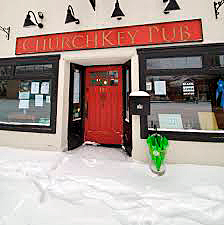 It is
noteworthy that one of England's largest
ecclesiastical insurance companies advises that generally churches are left
unlocked. This may seem paradoxical but the reasoning is sound: if the
church is locked then the thieves will cause considerably more damage by
breaking and entering than just walking in through the door, and, if they
are up to no good in the church, someone may simply walk in at any time,
as I have often discovered , and catch them in action. Insurance
companies are neither benefactors nor benign so we must assume they know
what they are talking about.
It is
noteworthy that one of England's largest
ecclesiastical insurance companies advises that generally churches are left
unlocked. This may seem paradoxical but the reasoning is sound: if the
church is locked then the thieves will cause considerably more damage by
breaking and entering than just walking in through the door, and, if they
are up to no good in the church, someone may simply walk in at any time,
as I have often discovered , and catch them in action. Insurance
companies are neither benefactors nor benign so we must assume they know
what they are talking about.Even if the church is locked and no permission has been given, there is often a note on the door or at the church yard gate giving the name, address or telephone number of the key holder or occasionally several key holders. So always take a mobile phone, one of the most annoying yet useful devices ever to be invented. It may be, and often is, the house next to the church or somewhere in the village; rarely, if the church is in an isolated position remote from any houses,the key holder may live some distance away - so forget public transport. These key holders are always delightful and helpful people, often quite elderly, and look after the church keys on a purely voluntary basis: they feel the are performing a necessary and helpful duty, which they are, and we should be grateful for such people. Sometimes when you telephone, the key holder will arrive by car (not yet on a motorbike but I look
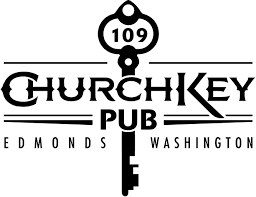 forward to that day) and open the door for you; they will
ocassionally go away and ask you to telephone them again when you are
finished so they may return and lock the church. On other occassions
they stay in the church, performing various and possibly irrelevant
tasks, to keep an understandable, but still
slighlty irritating, eye on you. Unfortuntely sometimes they follow you
around the church and will not stop talking, sometimes giving you
interesting informtion but at other times not.
forward to that day) and open the door for you; they will
ocassionally go away and ask you to telephone them again when you are
finished so they may return and lock the church. On other occassions
they stay in the church, performing various and possibly irrelevant
tasks, to keep an understandable, but still
slighlty irritating, eye on you. Unfortuntely sometimes they follow you
around the church and will not stop talking, sometimes giving you
interesting informtion but at other times not.If there is no information at the church, you could try the vicarage, but this is becoming more difficult as will be explained in another posting; the pub, yes I did come across one pub which actually was the key holder, otherwise someone in there might know, perhaps even the vicar; or the post office, which themselves are also becoming increasingly rare.
You should always obtain permission to visit the church and take photographs if you possibly can - apart from any other reason - it is only polite to do so - but always stress that it is for academic or research work and not for commercial gain or profit. Although this is becoming increasingly difficult as will be explained in due course.
I always try to write to the person in charge of the church I plan to visit to ask if it is open and if I may take photographs; when I do I usually receive a positive reply. Occasionally, because I forget to write, come upon a church I had not planned to visit, or receive no reply, for reasons which will be referred to in due course, the church is more often than not open. Here are three which were locked. You will note here that in all cases the key holder remained with us during our visit to the church, but this is not always the case.
1. The Peep-Toe Mail
In the North Riding, so the book tells me, there is a church in a village called Whorlton-in-Cleveland and this church contains a well preserved wooden effigy of a knight; I know of no other example in the North Riding, although Alfred Fryer in his book on Wooden Effigies does list several in the West Riding, most of which may be found elsewhere on this site. If you put this village's name into your Sat Nav you may well find t
 hat it is 'not
recognized', as the current phrase goes, which clearly sounds more
professional than, although means exactly the same as, 'dunno'! Help is at hand - need I add -
from the Ordnance Survey. There is another Whorlton, which is near
Barnard Castle, both in County Durham; that's not the one,
hat it is 'not
recognized', as the current phrase goes, which clearly sounds more
professional than, although means exactly the same as, 'dunno'! Help is at hand - need I add -
from the Ordnance Survey. There is another Whorlton, which is near
Barnard Castle, both in County Durham; that's not the one, although with boundary changes you would be forgiven for thinking
that perhaps it might be. The book also states that the parish church of
Whorton-in-Cleveland is at Swainby; this confusing statement will become
clearer later. The Ordnance Survey map shows that
Swainby is a medium sized village with a pub and a church (with spire)
and, if you go over the river bridge in that village, you will pass this
church and eventually reach Whorlton, as it is simply called
on the map. This has just a scattering of buildings (probably mostly
farm buildings) and a church
(with tower) as well as a castle. When you do the actual journey you
will find that the church in Swainby, which you will find to be
indeed a medium sized village, is a late
19th century building dedicated to the Holy Cross, but when you pass over
the small bridge and reach
Whorlton there is virtually nothing there except for a ruined castle and
a medieval church , also partly ruined and also dedicated to the Holy
Cross. Apparently what we find is explained by there once being a
medieval village here but which was abandoned long ago; this may have been
owing to the
plague or mass movement for other reasons. There is little or
nothing of this
villageto be seen above the ground now. The area is still called
Worlton-in-Cleveland and its church referred to Whorlton Old Church.
although with boundary changes you would be forgiven for thinking
that perhaps it might be. The book also states that the parish church of
Whorton-in-Cleveland is at Swainby; this confusing statement will become
clearer later. The Ordnance Survey map shows that
Swainby is a medium sized village with a pub and a church (with spire)
and, if you go over the river bridge in that village, you will pass this
church and eventually reach Whorlton, as it is simply called
on the map. This has just a scattering of buildings (probably mostly
farm buildings) and a church
(with tower) as well as a castle. When you do the actual journey you
will find that the church in Swainby, which you will find to be
indeed a medium sized village, is a late
19th century building dedicated to the Holy Cross, but when you pass over
the small bridge and reach
Whorlton there is virtually nothing there except for a ruined castle and
a medieval church , also partly ruined and also dedicated to the Holy
Cross. Apparently what we find is explained by there once being a
medieval village here but which was abandoned long ago; this may have been
owing to the
plague or mass movement for other reasons. There is little or
nothing of this
villageto be seen above the ground now. The area is still called
Worlton-in-Cleveland and its church referred to Whorlton Old Church. You may park outside this church and enter the church yard but, although the church is mainly a ruin, the chancel and the tower have been restored and are in good condition, services being held there at intervals. The churchyard, which contains a number of interesting head stones, may be entered may through its gate but the restored part of the church is locked and there is, at least when we visited, no indication of where to obtain the key. I could not see the wooden knight through either window or keyhole.
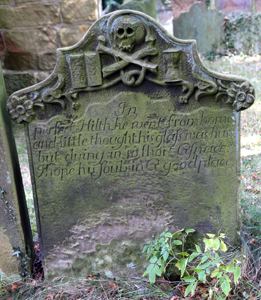 However
the internet, that sometimes fickle friend, came to the rescue here:
there is quite a lot of information about the lost village, the
castle as well as Whorlton Old Church, including the e-mail address
of the person
However
the internet, that sometimes fickle friend, came to the rescue here:
there is quite a lot of information about the lost village, the
castle as well as Whorlton Old Church, including the e-mail address
of the person 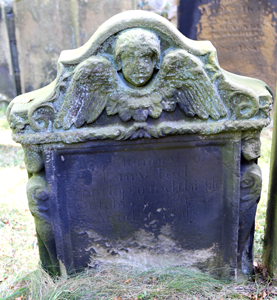 who
holds the key. I contacted this person and arranged to telephone her
when we next we visited God's Own County. This I did and we arranged
to meet
in the car park of Swainby church and then both drive in tandem to the Old
Church. She was a very friendly and helpful lady who knew a good
deal about the history of the church, even giving us a booklet on
the subject. She pointed out some interesting features both inside
and outside the church, such as the two sided tomb stones with
images of death on the one side and resurrection on the other, which
are here shown to the left and right.
who
holds the key. I contacted this person and arranged to telephone her
when we next we visited God's Own County. This I did and we arranged
to meet
in the car park of Swainby church and then both drive in tandem to the Old
Church. She was a very friendly and helpful lady who knew a good
deal about the history of the church, even giving us a booklet on
the subject. She pointed out some interesting features both inside
and outside the church, such as the two sided tomb stones with
images of death on the one side and resurrection on the other, which
are here shown to the left and right.This knowledgeable lady also pointed out a mass dial on the south outside wall of the church. A photograph of this particular example is shown below on the left. It is said that the six days of the week are represented by the circular row of the lower holes and Sunday is represented by the hole in the centre of the arc of the circle they form. An itinerant priest, if the church had no resident one, would put a light coloured stone in the relevant hole to indicate the day of the week that mass was to be held in the coming week.
There appear to be another variation of mass dials which are sometimes called scratch or tide dials. There are said to be more than 3,000 of these on church walls in England, although some are faintly scratched, and certainly worn, rather than deeply cut as is the example at Whorlton and hence easily missed. A photograph of a rather enhanced one is shown below right.These are in effect vertical sun dials and were always on the outside south wall (the sunny side) of the church near the priest's door. If the are not on this wall, being on another wall or inside the porch, then some rebuilding has occured or a porch added to the church The term scratch is obvious as they appear to have been at times simply and possibly crudely scratched onto the wall; the term tide is derived from tid, an Old English term for a period of time, these dials first appearing in Anglo-Saxon times. Incidentally the use of the word referring to the rise and fall of the sea from the gravitational action of the Moon did not appear until Late Middle English. These dials consist of an incised circle, the lower semi-circle of which has thirteen small holes cut at equal angles around the circumference of this semi-circle and incised radii passing from the large central hole to these holes. Five of these incised radii are more deeply incised. The large central circle held the gnomon (a wonderful word, derived from Greek meaning one who knows) often just a wooden stick, which cast a shadow over the lines. The holes indicated the hours of the day, beginning at 6.00 am and ending at 6.00 pm. The more deeply incised lines represent the times of the Divine Offices, the times of the five daily prayers in a medieval church day. By the 14th century these dials were progressively replaced by mechanical clocks, which initially were erratic in their timekeeping. The plain upper semi-circle represents night time, not an effective time for sun dials!
These dials could not be adjusted for longitude, so would not give the country's 'universal' time but only the local time, although local time is, after all, the real time, as told by the sun. People did not worry too much about this until as late as 1880 when the coming of 'high speed' travel on the railways made it essential to introduce a universal time. Otherwise it would be worse travelling east to west on a USA railway where you have to adjust your watch by an hour when you enter another universal time zone, the east-west width of this country being far too large to have a county wide universal time zone; before the railways and universal time it would meant alteringyour watch each village village visited and by any amount.
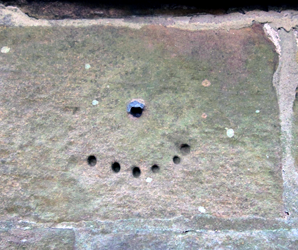 |
 |
 |
| The wooden knight we see in the photograph above appears to be wearing 'peep-toe' mail stockings, an extremely rare feature, which is mentioned in Fryer's book. There have been various explanations of this curious feature but my own opinion is as follows. The figure is very well carved and appears to have suffered very little damage or vandalism: note the details of the sword belt and spurs. However the mail is not carved at all where, in normal circumstances, it would be exposed, such as on the arms, legs where the surcoat falls back, and the mail hood; it is highly unlikely that the sculptor would have failed to have done this. Effigies of this date were often coated with a thin layer of a plaster like substance called gesso, and fine detail, such as mail, was simple stamped into it, this being a simpler and much quicker process than actually carving all the mail links. The gesso would than be painted. Thus the outline of the mailed toes could still be seen under this coat of gesso. This cost eventually flakes away which explains the state of the effigies today. |
However there are other explanations: one is that the mail was cut short of the toes to make movement more free and the knight would have worn a pair of leather hose beneath, a sort of shoe/sock combination; or that the toes were carved by some skillful vandal. I have no idea what it is like to walk in mail foot wear, allthough the knight in this period would have fought on horseback, but mail shoes are available to buy on the internet if you wish to find out! So I think the open toe idea can be dissmissed.
But there is another effigy of a knight in Pickering, also in the North Riding. This effigy is of Purbeck Marble and the knight wears a later variation of the armour seen here. Purbeck Marble is a hard stone to carve but all the mails links have been carved into the stone where the mail would have been exposed: but his toes are carved , by the looks of it, on one foot only! I think this may be apparent as I could not stand close enough to the effigy to make out the detail more clearly. I know of no other examples with this curious feature. ***
2. The Pretty Girl Holds the Key
Key holders of these locked churches are more often than not middle aged, or even elderly, people who have been trusted to keep the keys safely, only releasing them to those who appear trustworthy, and who often live in a cottage near the church. This proved not to be the case when I visited a church in Somerset a few years ago when I was taking a series of photographs of monuments in that county to add to the Church Monuments Society website; I was Hon. Publicity Officer of the Society at the time and these photographs were to promote the Society's symposium at Bristol, which had been organized by Dr Clive Easter. I had failed to arrange a visit to the church but, in this case, there was a note on the church door stating that the key may be obtained from the house behind the church. I walked round the church to the house but this was no cottage, but rather a large, fine and old manor house. I expected the door to be answered by the maid, but instead there appeared an attractive young woman dressed in what is known as 'hippy' style with long skirt, long free hair and no shoes. She proved very friendly and chipper and walked over to the church with me, still shoeless, to open the church door. She remained with me in the church while I took the photographs, chatting and asking me questions. I often wondered how she managed to walk barefoot on a cold church stone floor.
It wasn't until several years later that I found out who this delightful young lady was or might have been, as this manor house was no longer such but a hotel, or rather one of a number of holiday cottages and manor houses now converted for that very purpose.
3. Private Property - Keep Out
Another locked church we attempted to visit was at Kirkby Fleetham, also in the North Riding. Your Sat Nav will certainly guide you to the village but not to the church which is a short drive away from the former. So it's
 Ordnance
Survey to the rescue again, either the 1:50 000 map or the O/S Sat
Nav. In fact you need neither of these as the church is
signposted in the village, although this is easy enough to miss, at least
initially, but I always advise a
Ordnance
Survey to the rescue again, either the 1:50 000 map or the O/S Sat
Nav. In fact you need neither of these as the church is
signposted in the village, although this is easy enough to miss, at least
initially, but I always advise a 1:50 000 map when monument hunting, as churches are not always quite where you think they should be. We soon came to a pull in on the right hand side of the road with two large gates, one signposted 'Home Farm' and the other 'Kirkby Fleetham Hall'; there was also a small sign by the latter gate: 12th Century Church. We drove through the relevant gate, which was open, and along a drive through a wooded area. On either side there were notices fixed to the trees, telling the reader to Keep Out! and that it was Private Property; not an encouraging welcome. We eventually came to a clearing where the church was in front of us. To the right was Kirkby Fleetham Hall, a fine large Grade II* early 18th century house, which has been a private house, a hotel, but was now partly let out as apartments. An occasional person wandered in front of the Hall but no one challenged us. Surprisingly there was not a shot gun or fierce dog in sight. To the left was a car park with the notices: No Parking and Private: Residents Only. Fortunately there was a small area of somewhat informal parking in front of the church. As expected the church was firmly locked. However there was a notice board giving the name and telephone number of the current vicar.
We intended to visit this church on our next visit to the North Riding but had lost the details of the vicar who, it transpired, had moved to another parish anyway, leaving the church in 'interregnum'. The details of the
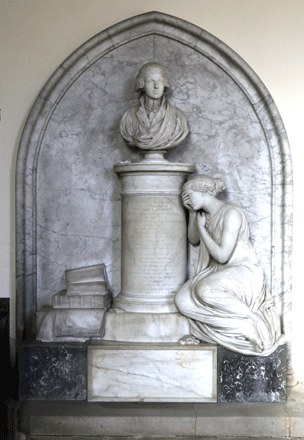 person to contact was on the
church's website and I e-mailed the person concerned,
who was one of the church wardens. A reply came from a lady and I arranged to telephone her when we had
arrived in the North Riding. It is quite difficult to make these
appointments precisely since it is impossible to accurately plan the
times ahead. I telephoned on a suitable day and we arranged to meet
outside the church. I asked about parking and was told to simply
park on the grass verge outside the church as that was the normal
arrangment.
person to contact was on the
church's website and I e-mailed the person concerned,
who was one of the church wardens. A reply came from a lady and I arranged to telephone her when we had
arrived in the North Riding. It is quite difficult to make these
appointments precisely since it is impossible to accurately plan the
times ahead. I telephoned on a suitable day and we arranged to meet
outside the church. I asked about parking and was told to simply
park on the grass verge outside the church as that was the normal
arrangment. There were the two gates and the notices giving
information but the hostile notices fixed to trees along the drive
had now gone. We parked on the grass as arranged and the key holder lady
arrived shortly afterwards; she was, as ever, a very helpful person and keen
to tell us all she knew of the church. I asked her about the
local situation and
was told that the Hall had recently been sold to another owner, so hence the
welcomed disappearance of those unwelcomed notices, that the forbidden car
park served a number of properties, which we could not see, on the other side of the church
to the Hall, and, as mentioned, that the
vicar had left now the parish. She unlocked the door and I was delighted
to find a number of fine monument sinside, including the
cross legged knight, shown below, who is locally referred to as 'The
Crusader'. Although certainly not a crusader this is a very fine
stone effigy indeed. Note the fine carving of the mail, sword and
sword belt and the heraldry on the shield, which are, as often as
not, quite blank, the heraldry having once been painted but having
since disappeared. Note the toes are not suggested at all.
There were the two gates and the notices giving
information but the hostile notices fixed to trees along the drive
had now gone. We parked on the grass as arranged and the key holder lady
arrived shortly afterwards; she was, as ever, a very helpful person and keen
to tell us all she knew of the church. I asked her about the
local situation and
was told that the Hall had recently been sold to another owner, so hence the
welcomed disappearance of those unwelcomed notices, that the forbidden car
park served a number of properties, which we could not see, on the other side of the church
to the Hall, and, as mentioned, that the
vicar had left now the parish. She unlocked the door and I was delighted
to find a number of fine monument sinside, including the
cross legged knight, shown below, who is locally referred to as 'The
Crusader'. Although certainly not a crusader this is a very fine
stone effigy indeed. Note the fine carving of the mail, sword and
sword belt and the heraldry on the shield, which are, as often as
not, quite blank, the heraldry having once been painted but having
since disappeared. Note the toes are not suggested at all.On the right is the monument to William Lawrence (1785) by Flaxman. On the left side of the pedestal is a pile of books while on the right Anne Sophie mourns beneath the bust of her husband. Below her knees may been seen a pile of coins. I have not been able to discover who this William Lawrence was but his wife was the heiress to the Studley Royal estate, near Ripon
 |
In the good old days before the occasional wonders of the internet and e-mails, I would always write to vicars and rectors, enclosing a stamped addressed envelope, to ask permission to visit the church and take photographs. I would nearly always receive a reply giving permission; very occasionally a polite request for me to put a small donation in the box was added.
I cannot recall where or when this occurred but I wrote to one vicar and no reply arrived after waiting several weeks. I visited the church anyway, the door was unlocked and I took the photographs. Then more than a year later a letter arrived with my handwriting on the envelope: it was from this very vicar who apologized profusely, telling me that my letter had become lost under a pile of papers and, of course, I may visit the church and take any photographs I wished, if I had not already done so.
The was no request for a donation but I had put one in the box a year earlier.
And the Post Office
Let us sort out some terminology before we begin.
In England it was always the postman: you may remember it was Postman's Knock, never Postladies' Knock so the poor girls never got a chance. Postman Pat was Patrick not Lady Postman Patricia and the Post Man Always Rang Twice. Although women did carry out this essential work they were certainly in the minority in the past, it always being a postman who delivered the mail to our house. Incidentally in the USA, it's the mailman who delivers the post. So instead of using the long and clumsy phrase, postman or postwoman, let us use the gender free word, postie. The dictionary informs us that this word is Informal English but I was always under the impression that it was Scottish, the Scots being of a more sensible and practical nature.
 In France
we have a problem with clumsy phrase reduction. The
majority of deliverers of the mail now appear to be women, all of whom
sport pony tails, although this may well be my personal observation and
not a requirement of employment. In French you cannot, as far as I know, perform this gender freeing of the noun as bizarrely nouns have
their own gender even if the person they refer to is actually of the
opposite gender: an example of this is that the word for mayor is
le maire (masculine) and, even if the maire is a woman she
is still referred to as Madame (feminine) le Maire
(masculine). Rather like saying a lady postman! How a
word can possibly have a gender has never been explained to me. The
postman is le facteur and the postwoman la factrice.
But they will not be here: they are French Posties.
In France
we have a problem with clumsy phrase reduction. The
majority of deliverers of the mail now appear to be women, all of whom
sport pony tails, although this may well be my personal observation and
not a requirement of employment. In French you cannot, as far as I know, perform this gender freeing of the noun as bizarrely nouns have
their own gender even if the person they refer to is actually of the
opposite gender: an example of this is that the word for mayor is
le maire (masculine) and, even if the maire is a woman she
is still referred to as Madame (feminine) le Maire
(masculine). Rather like saying a lady postman! How a
word can possibly have a gender has never been explained to me. The
postman is le facteur and the postwoman la factrice.
But they will not be here: they are French Posties.Returning to England there is a similar situation with the clergy. It was always a clergyman as women were forbidden to become 'of the cloth'. Very foolishly in my opinion, although I do not base this on any ecclesiastical or rational argument, but to the fact that the Queen - a woman - is the Head of the Church of England. What nonsense! But now women can at last be ordained ministers of the Church of England and so all clerical posts are open to them. The non-conformist church became more enlightened long before the C of E. So we shall avoid the long and clumsy term clergyman or clergywoman and instead they are clerics from now on.
So praise to the postie and to those backroomers (gender free) who sort the mail. They manage to bring the post to the right person, even if the writing is virtually illegible and the address a
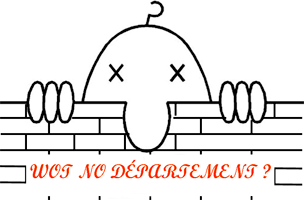 muddle or even completely wrong. I now normally e-mail a church (if I
can find the e-mail address, which sometimes I cannot) for permission to
photograph but the response is poor: I may only receive replies to
two-thirds of the e-mails I send. Why? Mainly because I find the e-mail
on a site such as A Church Near You and the e-mail address has
not been updated, my e-mail simply going nowhere at all.
muddle or even completely wrong. I now normally e-mail a church (if I
can find the e-mail address, which sometimes I cannot) for permission to
photograph but the response is poor: I may only receive replies to
two-thirds of the e-mails I send. Why? Mainly because I find the e-mail
on a site such as A Church Near You and the e-mail address has
not been updated, my e-mail simply going nowhere at all.Once upon a time it was easy, although this account is simplified. Each parish had a vicar (or rector, but we'll use vicar for simplicity in this article) and the parish had a parish church, the vicar living nearby. Then came joint benefices where the vicar had more than one parish and its church under his charge; but where did he live? Then came team ministries where a team of clerics look after a number of parishes, with ten or more under their charge. The 'boss' cleric became known as the Team Rector and his lieutenant or lieutenants the Team Vicar or Vicars. These terms bear no relationship to the original use of the terms vicar and rector. Some of these clerics were no longer granted the freehold of the church, becoming known as priests-in-charge. Other churches became 'redundant' - an ill conceived term - meaning they were no longer used for regular (although for occasional) worship and no longer a parish church. If I addressed an envelope to The Vicar, St Mary's Church, Sometown the postie, being ever resourceful as well as having local knowledge, always delivered the mail to the correct address be it a vicar, church warden or a caretaker in charge of the church in question even if the vicar as such no longer existed or even if the church were redundant.
The internet being quick but thick simply cannot do this.
Post Codes. Let us have a look at these curiosities. The post code of the United Kingdom goes like this:
| AB 12 3CD |
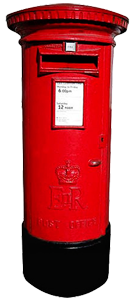 The first two letters give what is
known as the postal area and subsequent letters and digits give
progressively smaller units within this area until the street, block of
houses in a street , or even building is specified. This must make the
job of the postal workers much easier. Note that this is not based on
counties or parishes, the post codes having been devised rationally as
well as specifically for postal use. Incidentally the
initially letters are derived from the
principal town in the specific postal area: I made up AB but it actually stands for Aberdeen,
GU is for Guildford and so on. You can often guess which town the pair of
letters represent. The post office states that you do
The first two letters give what is
known as the postal area and subsequent letters and digits give
progressively smaller units within this area until the street, block of
houses in a street , or even building is specified. This must make the
job of the postal workers much easier. Note that this is not based on
counties or parishes, the post codes having been devised rationally as
well as specifically for postal use. Incidentally the
initially letters are derived from the
principal town in the specific postal area: I made up AB but it actually stands for Aberdeen,
GU is for Guildford and so on. You can often guess which town the pair of
letters represent. The post office states that you do not need to enter
the county of the destination when you are addressing an envelope if you
use the post code.
not need to enter
the county of the destination when you are addressing an envelope if you
use the post code.Unfortunately this post code is often used for purposes for which it was not intended, such as giving directions to emergency, delivery and service vehicles as well as finding directions on Sat Navs. In thinly populated country areas the post code can direct you to a relatively large area where the house you are looking for will still be difficult to find; I have experienced this while looking for houses on my rounds. It would be more sensible as well as considerably more accurate to pinpoint your location or destination using a map reference. Using the National Grid from the Ordnance Survey would do just that and it is simple to use; well, of course!
However, the French post code (Code Postale) goes like this:
| 12 34 0 |
All digits and therein lies the problem. The first pair of digits give the département; there are about a hundred of these and they roughly equivalent to an English county, although frequently much larger. The second pair of digits gives the commune, which can be a village, town or city: there are over 36,000 of these. The final digit is usually 0 but if you want to understand this curiosity visit this website . The 'correct' form of addressing an envelope bound for a French location is name, street, post code and commune. Note that although the commune is named, the département is not. Thus the French Post Code was not specifically designed for postal services, like that of the United Kingdom, but was rather based on previous administrative areas. It does not direct the postie or sorter to a group of houses but to only to the whole commune so the posties have to have detailed local knowledge of all the houses in the commune, or, if their rounds are split, the part of the commune they serve. Communes can be very small (55 inhabitants in the smallest at the moment) or very large: for example Paris itself, although this city is subdivided into separate postal areas, as are Lyon and Marseilles. Now if the sender makes a mistake in entering just one the first two digits of this code, the letter will go to the wrong départment and it is then quite difficult to work out for which commune it is bound. The commune has a number but this is not unique but recurs in other départments, otherwise it would be five digits long. The actual name may be unique although there are very often several communes with exactly the same name. So there will have to be a lot of searching in that wrong départment head post office to find the correct commune but, being resourceful postal workers unlike those who designed the code, they will. That is why I always put the départmente name on the envelope. I was sent a parcel with the wrong départment code which did reach me eventually, although it did take six months.
So .....
 |
They don't just push stuff through your letter box: they act as social workers, lookouts, helpers, friends, and lots of other roles too.
Whether We Like It Or No
Bayeux is a town in Normandy, where many of its cafés offer reduced price meals to veterans of the D-Day Landings, now a sadly diminishing number, for their help in liberating their town and its people from the German occupation during World War II. A very thoughtful and kind gesture. The town is noted for the famous Bayeux Tapestry, a magnificent medieval work although not actually a tapestry, which is now housed in a splendid museum, and its Cathedral. It may be said to be noted for two other things: one is a tombstone in the cemetery with a full size effigy of a kneeling, naked lady, and the other? Infamous is the more suitable word.
 We began walking
along the main shopping street when we were assaulted by very loud music
emanating, so I thought, from an open window of a flat above one of the
shops. Someone was perhaps kindly entertaining passers by with their
choice
We began walking
along the main shopping street when we were assaulted by very loud music
emanating, so I thought, from an open window of a flat above one of the
shops. Someone was perhaps kindly entertaining passers by with their
choice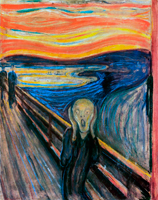 of music or, on the other
hand, maliciously trying to annoy the same with
it. There is only one
answer to this sort of situation and that is to walk on, preferably as
quickly as possible. But the music did not diminish no matter how far we
walked away from the open window. And that was because it was coming from a
series of speakers strung along the street at intervals. This is a
pleasant French town, not a fairground! Unfortunately this music form
appears to be spreading around the towns and cities of France,
rather like the Plague, for a plague it certainly is!
of music or, on the other
hand, maliciously trying to annoy the same with
it. There is only one
answer to this sort of situation and that is to walk on, preferably as
quickly as possible. But the music did not diminish no matter how far we
walked away from the open window. And that was because it was coming from a
series of speakers strung along the street at intervals. This is a
pleasant French town, not a fairground! Unfortunately this music form
appears to be spreading around the towns and cities of France,
rather like the Plague, for a plague it certainly is!Some people appear to think that music is the be-all and end-all to life, be it hard rock or hard opera or even every form of music. I am inclined to favour the opinion of Alexander Borodin, the Russian composer, who is said to have commented that music is a pastime, a relaxation from more serious occupations. He was also a Professor of Chemistry. It is not that I dislike music: some I do like, most I tolerate, but some particular forms I detest.
One is musak. Why do those in authority think that we all want to list to this background music that they choose all of the time? Many restaurants play it, so we never return. Hypermarkets play it, specializing in a particularly wailing or repetitive variety, so whenever possible we now shop online. If people really want music all the time, personal stereos have reached amazingly sophisticated heights which would never have been thought possible a generation ago. It is the lack of choice which is so annoying: take it but you can't leave it!
Another is church organ music.
I do not actually have to hear one of these ugly pieces of plumbing to be irritated: the very sight of them is enough. Frequently they are big, sometimes enormous; occasionally they are far too big for the church
 into which they have been shoehorned. They often block sections of the
church so obscuring monuments, particularly wall monuments, which become
difficult to see and often impossible to read. And it is not just
monuments, which in itself is insulting to the commemorated. In Exeter
cathedral a row of organ pipes sits on top of the pulpitum and obscures
what would have been - and used to be - a magnificent uninterrupted view
along the nave and choir; these monstrosities were never meant to be
there in the first place and simply do not belong. Several other
cathedrals have done exactly the same and this practice often receives well
deserved
criticism by writers on architecture, such as Alec Clifton-Taylor. Their
positioning is rather like building a high rise tower block in the middle of
Trafalgar Square.
into which they have been shoehorned. They often block sections of the
church so obscuring monuments, particularly wall monuments, which become
difficult to see and often impossible to read. And it is not just
monuments, which in itself is insulting to the commemorated. In Exeter
cathedral a row of organ pipes sits on top of the pulpitum and obscures
what would have been - and used to be - a magnificent uninterrupted view
along the nave and choir; these monstrosities were never meant to be
there in the first place and simply do not belong. Several other
cathedrals have done exactly the same and this practice often receives well
deserved
criticism by writers on architecture, such as Alec Clifton-Taylor. Their
positioning is rather like building a high rise tower block in the middle of
Trafalgar Square.But the sound they produce - to my ears - is a jumble, a cacophony; they are often played far too loudly and their low notes frequently cause the foundations of the church to vibrate. When a service is over members of the congregation often like to meet at the west end of the church for a chat but then the organist often likes to show his skill and virtuosity by playing as loud, as long and with as many tricks as he possibly can so that conversation is impossible, disco like. A majestic sound perhaps but one I can well do without.
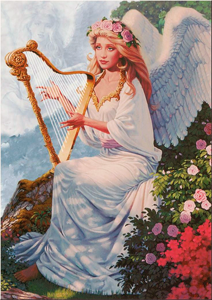 We often think that organs have somehow always been there, that
they are somehow an essential and fundamental part of Christianity
itself. This is not so: it used to be the amateur village band who played in the church, who were
possibly not all that skillful but were certainly in keeping with the
spirit of the local church. I know of a church where the organist was paid
£5,000 a year to play in a relatively small church that was always short of
money. In one of
Thomas Hardy's less pessimistic novels - Under the Greenwood Tree
- the resistance of the church band to the vicar's introduction of an
organ is well described. But, as is often the case, real life can be
more exciting than fiction: in a village church somewhere in England,
the vicar, who was also the squire's brother, introduced the organ into
his church causing much annoyance to the village band who had always
provided music for the church. One Bonfire Night - chosen because the
sound of fireworks would obscure what was about to be done - a group of
villagers entered the church, blew up and destroyed the organ. Who was
it? The village band, perhaps, who felt rejected; a group of villagers
who had been mistreated by the squire or had some argument with the
vicar. It was never discovered but I raise a glass to such gallant and
public spirited miscreants!
We often think that organs have somehow always been there, that
they are somehow an essential and fundamental part of Christianity
itself. This is not so: it used to be the amateur village band who played in the church, who were
possibly not all that skillful but were certainly in keeping with the
spirit of the local church. I know of a church where the organist was paid
£5,000 a year to play in a relatively small church that was always short of
money. In one of
Thomas Hardy's less pessimistic novels - Under the Greenwood Tree
- the resistance of the church band to the vicar's introduction of an
organ is well described. But, as is often the case, real life can be
more exciting than fiction: in a village church somewhere in England,
the vicar, who was also the squire's brother, introduced the organ into
his church causing much annoyance to the village band who had always
provided music for the church. One Bonfire Night - chosen because the
sound of fireworks would obscure what was about to be done - a group of
villagers entered the church, blew up and destroyed the organ. Who was
it? The village band, perhaps, who felt rejected; a group of villagers
who had been mistreated by the squire or had some argument with the
vicar. It was never discovered but I raise a glass to such gallant and
public spirited miscreants!Noise pollution is becoming an increasing problem and one which is becoming increasingly difficult to escape from. It is also an identified major cause of psychological stress, although many people are not aware of this, even though they may suddenly feel more relaxed when the noise finally ends. There are basically two types of noise pollution. The first is what might be considered a by product of some activity which although noisy, sometimes very much so, the production of noise is not the actual aim of that activity. Such noises arise from building work, traffic, aircraft and machinery; I read a case once where some town folk moved to the country and registered a complaint about a cock crowing. Such noises have one important feature in that it is possible, although often difficult, to escape from them as they are transient or local: if you do not like the cock crow simply do not move to the country. I know in reality it can never be as simple as this: for example those latest disturbers of the peace, leaf blowers, make an excessive noise and really should not be used until there is some control of their production and use.
The other type of noise is when the noise is actually an end in itself. Indoor warnings such as the telephone, clock chimes and smoke alarms of a volume suitable for their purpose. The outdoor warnings includes the noise of church bells, fire alarms, burglar alarms, fog horns, various other horns whose functions are warning, informing and summoning. These are outdoor and transient sounds so are necessarily loud and, because of their functions, often strident and generally unpleasant to listen to; it would be unreasonable to use them inside a building especially one where the acoustic properies enhances them.
But read on.... .
A few years ago, we travelled to Rouen in Normandy to visit the Cathedral, made famous by the Impressionist painter, Monet, to see and photograph the monuments which include an effigy over the heart burial of King Richard I. We were concerned about the arrival of a number of men dressed in hunting outfits, the style of dress that gives members of the League Against Cruel Sports a rise in blood pressure. There were no foxes - and they did not bring those revolting hounds with them: what they did bring were their hunting horns. It was a concert, a concert of organ and hunting horns. The sound was dreadful and loud in the extreme, reverberating around the cathedral; to my ears it was reminiscent of a jet fighter flying low overhead which sounds like the sky is being ripped apart. These horns are powerful in order to serve a pupose in the open air: they are not strictly musical instruments and should never be blown inside a building. The concert was well attended; I would prefer a concert of pneumatic drills with a flypast of Saab Viggens. I was not able to continue the photography, with that appalling noise filling the cathedral and filling my head. We left.
One of the useful things, although not an often considered one, about travelling around hunting for church monuments is that we visit places that we would never have visited and find things we would never have found.
We were delivered a lorry load of logs which were too long -
 twice as long
twice as long - to fit
our
wood burning stove. We needed a saw horse. I thought that everyone not
only knew
what a saw horse was but also actually look like. There's one at the end of
this line, if they are not familiar. I wanted one just like that which
would hold the log firmly with having to constantly adjust clamps for
this purpose and one sturdy and heavy enough not to collapse or tip over
while I was sawing. Easy? No. Where do you actually buy a saw horse? A
garden suppliers or an agricultural suppliers perhaps. I tried several
of these places but all they offered me were metal ones which look
suspiciously if the would overturn; one even came in two sections so you
would have to clamp each end of the log separately. I was shown
several workmates, but although excellent for many jobs were
not at all suitable for sawing logs,
especially a lorry load. I have one already and I've tried it.
- to fit
our
wood burning stove. We needed a saw horse. I thought that everyone not
only knew
what a saw horse was but also actually look like. There's one at the end of
this line, if they are not familiar. I wanted one just like that which
would hold the log firmly with having to constantly adjust clamps for
this purpose and one sturdy and heavy enough not to collapse or tip over
while I was sawing. Easy? No. Where do you actually buy a saw horse? A
garden suppliers or an agricultural suppliers perhaps. I tried several
of these places but all they offered me were metal ones which look
suspiciously if the would overturn; one even came in two sections so you
would have to clamp each end of the log separately. I was shown
several workmates, but although excellent for many jobs were
not at all suitable for sawing logs,
especially a lorry load. I have one already and I've tried it.And one other good thing about a hefty wooden saw horse is that if those confounded 'environmental activists' (who prefer burning fire damp to burning logs) ever get their way (and may it never happen) you can always saw up the saw horse before the ban comes. OK, I'll need another saw horse to do that, but I'll worry about that when it happens.
We travelled to Yorkshire a few years ago for a holiday and to visit family and friends as well as to hunt for monuments. We were driving along to a village called West Tanfield, on the River Ure, which is well worth visiting as the church (unlocked) has several medieval effigies, some having seen better days, but all of interest. Several were drawn etched by T & G Hillis; their work may be seen on the relevant page on this site. The church and village are both beautifully cared for. The medieval tower behind and to the side of the church in the photograph is the gate house of the now dissappeared manor house where the Marmion family lived 1285-1387. Although it is known as the Marmion Tower it post dates the family, being of the 15th century.
We did not visit one of the two pubs which are both Grade II listed buildings. This omission will one day be corrected.
As we were approaching the village we saw a sawhorse - just the one too - on the pavement. With a number of other items it was outside a joinery shop which made and sold similar sturdy wooden item. We bought the saw house and a coat rack and it rather looks like one of those places we may well visit again.
And I took the photographs too.
4. The Never Open Door
The part of the Industrial North where I spent my younger years is not famous for its medieval architecture, the odd heavily restored church, perhaps, but little else. The little there is I could only reach by bus or train, staying overnight
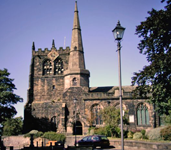 anywhere being quite
out of the question. Perhaps this is why I like all things medieval.
Consequently when I bought my first car - many years ago now - I went
(as programmes and books are often called) in Search of the Middle Ages.
I began with the cathedrals, one reason for this being that I had
developed an interest in medieval effigies after my grandparents took me, when I
was small, to St Peter and Paul's Church in Ormskirk, in which are
four such alabaster effigies. This church has a spire and separate tower and
a local, bogus tale tries to tells us why this came about. I did not, of
course, have a camera then and these effigies unfortunately remain
unphotographed by me to
this day.
anywhere being quite
out of the question. Perhaps this is why I like all things medieval.
Consequently when I bought my first car - many years ago now - I went
(as programmes and books are often called) in Search of the Middle Ages.
I began with the cathedrals, one reason for this being that I had
developed an interest in medieval effigies after my grandparents took me, when I
was small, to St Peter and Paul's Church in Ormskirk, in which are
four such alabaster effigies. This church has a spire and separate tower and
a local, bogus tale tries to tells us why this came about. I did not, of
course, have a camera then and these effigies unfortunately remain
unphotographed by me to
this day.On Saturdays I would often drive to a cathedral, or any large church, being able to travel very much further than ever before and visit places that would have been impossible to reach by foot or public transport. On holidays I would travel considerably further, staying somewhere overnight, and at last visit a number of places that had always interested me but were impossible for me to reach.
 One Saturday I drove to Leicester to
visit a certain
church there which, in this blog, will not be named. We found the church
easily and tried the door: it was locked. Church doors often stick or have
a difficult or strange way of operating the handle, so I tried turning
it in the opposite direction. This was still not effective but before we walked
away, the door was opened and a sour faced, robed figure appeared.
One Saturday I drove to Leicester to
visit a certain
church there which, in this blog, will not be named. We found the church
easily and tried the door: it was locked. Church doors often stick or have
a difficult or strange way of operating the handle, so I tried turning
it in the opposite direction. This was still not effective but before we walked
away, the door was opened and a sour faced, robed figure appeared.'What do you want?' said he, as if this were not obvious.
'We'd like to look around the church, if we may,' I said, to which he retorted, 'Well, you can't, we're starting a service shortly.' He then closed and locked the door.

No...'Perhaps you would like to join us: you would be very welcome'...or...'Come back in an hour when you may freely look around.' Nothing.
I often wonder if this rude and unpleasant man had an evening job: a doorman at a night club perhaps!
Many years later this particular church acquired - after objections from certain interested parties - what can best - although regrettably - be described as a tourist attraction. Perhaps their attitude of all those years ago would change? All welcome, perhaps?
I fear not. A while ago the authorities decided to stage a certain play in their church, a play which was related indirectly to this tourist attraction but which was extremely insensitive as well as presenting a very distorted, and rather silly, view of history. Unfortunately this is also a play from which many 'learn' the history of this particular period and excusably so because history lessons fail to enlighten while English lessons force this play on unfortunate children. An important member of a not insignificant historical society related to both the 'tourist attraction' and the unfortunate play requested that this decision be reconsidered. She was ignored.
Full circle?
The Lord Mayor's Chapel - also known as St Mark's Chapel - in the centre of the City of Bristol - is a church of great interest, containing a large number of monuments, especially for a church of its size. Although it is opposite the Cathedral, it is
.jpg) rather tucked away among the adjacent
commercial buildings, so you would be forgiven for giving it little
attention. It is also a very curious church with an interesting history.
rather tucked away among the adjacent
commercial buildings, so you would be forgiven for giving it little
attention. It is also a very curious church with an interesting history.It was originally the chapel of St Mark's Hospital (officially, the 'Hospital of St Mark of Billeswyke-by-Bristol') which had been founded by Maurice de Gaunt in 1220 as a daughter house of St Augustine's Abbey, Bristol, now the Cathedral. After the death of the founder in 1230, it was further endowed by his nephew, Robert de Gournay, who placed its control under Maurice's brother, Henry. It also became an independent religious community, no longer a daughter house of the Abbey, providing food
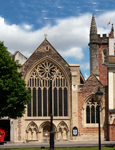 and
care for one hundred poor people per day. The effigies of these two
benefactors survive in the Chapel and are shown below. The Chapel is the
only surviving building of the Hospital, a term used to refer to what we
would now term an alms house.
and
care for one hundred poor people per day. The effigies of these two
benefactors survive in the Chapel and are shown below. The Chapel is the
only surviving building of the Hospital, a term used to refer to what we
would now term an alms house.With the Dissolution of the Monasteries, St Mark's Hospital came to an end in 1539, even though it was performing true charitable work. We can be thankful that the buildings and land were not sold by Henry VIII to one of his cronies but were only leased. Bristol Corporation objected to this arrangement and subsequently purchased them for the sum of £1,000. Around this time the Chapel was often known as 'Gaunt's Chapel'.
The buildings were used as schools but eventually either sold or demolished, although the chapel itself was spared, being used from 1687 to 1727 by the French Hugenots who had settled in Bristol when fleeing from religious persecution in France during the Wars of Religion. In 1722 the Hugenots moved to a new building nearby while about the same time the Chapel began to be used by the City Corporation as its own place of worship, following a dispute with the Cathedral. It now became known as the 'Lord Mayor's Chapel', as it is referred to today.
Today the chapel is classified as a Civic Peculiar -1, belonging to the Lord Mayor and City Council and not under the jurisdiction of the Bishop of Bristol. It is also non-denominational and has no actual parish. I understand that the minister in charge belongs to a specific Christian denomination but this rotates at intervals. When I visited the Chapel the current minister was a Methodist.
The Chapel is open to the public at restricted times which are given on their website. These appear to have varied greatly over the years.
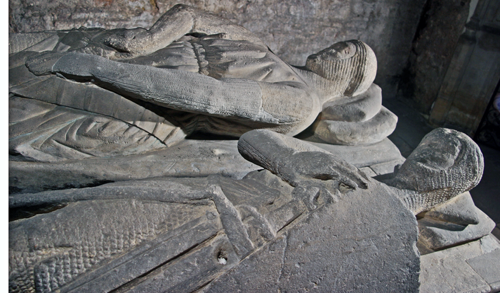 A few years ago my friend Dr Clive Easter
arranged a symposium based at Bristol University for the Church
Monuments Society, of which I was then Hon. Publicity Officer, one my duties being to advertise the symposium. To this end I
planned to visit the Chapel in order to take a number of photographs to
post on the Society's website. Coming from
Liverpool I had never
A few years ago my friend Dr Clive Easter
arranged a symposium based at Bristol University for the Church
Monuments Society, of which I was then Hon. Publicity Officer, one my duties being to advertise the symposium. To this end I
planned to visit the Chapel in order to take a number of photographs to
post on the Society's website. Coming from
Liverpool I had never really considered Bristol as a good source of
church monuments, presuming that the two cities had a very similar
history. I checked the books to discover I was completely wrong: Bristol is an
excellent source, with two large churches (the Cathedral and St Mary
Redcliff), and number of small churches (some no longer in use as such)
also with a number of monuments - and the Lord Mayor's Chapel.
really considered Bristol as a good source of
church monuments, presuming that the two cities had a very similar
history. I checked the books to discover I was completely wrong: Bristol is an
excellent source, with two large churches (the Cathedral and St Mary
Redcliff), and number of small churches (some no longer in use as such)
also with a number of monuments - and the Lord Mayor's Chapel.I consulted the website of the Chapel and found the opening times were rather restricted although, at that time, an arrangement could be made with the Verger, who would open the Chapel for interested visitors. I telephoned the Verger, a very friendly and cooperative man, whose name I remember was that of a cathedral, although not of Bristol. I explained my request and its purpose and we arranged to meet at a mutually convenient time outside the Chapel for it to be unlocked.
I travelled to Bristol by train carrying my increasingly heavy camera equipment and walked to the Chapel, arriving there in good time. The Chapel was locked and Verger was not there. I telephoned the number I had called earlier but there was no response. I waited half an hour or so but no one arrived. I checked my diary and all was correct.
Fortunately I noticed that the council offices were across the road from the Chapel so there I went, explaining the situation to the receptionist. She told me that the Verger was ill and so unable to fullfil his usual duties, which explained why the Chapel was locked and his non appearance. She also told me that I was in luck as the resident minister, who had the Chapel key, was in the building and that he would be returning to reception shortly. I was introduced to the Minister, an amiable man, who quite understood the situation and explained that, yes he could unlock the door but he would have to lock it again as the Chapel having no staff resident at the moment, could not be left open. As I had explained that it would take me at least an hour to take the photographs, he could not wait as he had another appointment. I then suggested that he locked me in if he could possibly return in say a couple of hours to unlock the door again. Yes, he could do that but was concerned I might take ill in the locked building without a key. I then had an idea: 'I can always use my mobile phone', said I, producing it from my camera bag, 'if you leave me your contact number.' This he agreed, locked me in the church, returning after a couple of hours to unlock the door again.
I was indeed lucky this time and I heard later that others had tried to access the Chapel around this time but had not been sucessful.
Unfortunately not everyone is as cooperative and reasonable as the Receptionist and the Minister, as will be seen.
|
-1
Peculiarer and Peculierer |
Peculiar is the legal term to define a church which does not fit into the general jurisdiction of the Church; it is 'exempt' from 'normal' procedures,  such as the
jurisdiction of the bishop of the diocese in which it is
situated. It other words its jurisdiction is peculiar to itself,
which explains the origin of this odd - or what might be considered
peculiar - word. It may be subject to that of a senior churchman
from another parish or diocese. There were a number of such
churches but the majority of peculiars were abolished in the
19th century, although a few remain. There are two basic types: Royal Peculiars
and Non-Royal Peculiars. such as the
jurisdiction of the bishop of the diocese in which it is
situated. It other words its jurisdiction is peculiar to itself,
which explains the origin of this odd - or what might be considered
peculiar - word. It may be subject to that of a senior churchman
from another parish or diocese. There were a number of such
churches but the majority of peculiars were abolished in the
19th century, although a few remain. There are two basic types: Royal Peculiars
and Non-Royal Peculiars. Royal Peculiars, as might be expected, include the chapels in the many royal palaces. However they 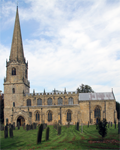 include other
churches and
chapels too: include other
churches and
chapels too:Westminster Abbey (not an abbey, of course, but a collegiate church). St George's Chapel in Windsor Castle (also collegiate). The two chapels in the Tower of London: of St John the Evangelist and of St Peter ad Vincular. The Temple Church, London. This is the Church of the Inner and Middle Temples, two of the four Inns of Court. Former Royal Peculiars include Wimborne Minster (Dorset) which was a Collegiate Church, and Dorchester Abbey (Oxfordshire), which  retains the name of its former status as an
abbey. retains the name of its former status as an
abbey.Non-Royal Peculiars include: 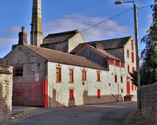 The Chapels of Lincoln's and Grey's Inns. Very peculiar as the church of the other two Inns of Court (the Temple Church) is a Royal Peculiar. Christ Church, Oxford, now a cathedral Chapels of the colleges of the University of Oxford. St Mary the Virgin, Masham, North Yorkshire St Mary the Virgin, Hornby, North Yorkshire. 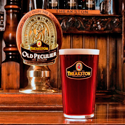 Note This list is
taken from the internet and there are certain inconsistencies,
which I have not yet resolved:- Note This list is
taken from the internet and there are certain inconsistencies,
which I have not yet resolved:-1. The Lord Mayor's Chapel, Bristol is not included although both their own website and the Wikipedia entry regard it as a peculiar. 2. Masham Church of St Mary the Virgin is included but an alternative spelling is also given as peculier; I do not know whether this applies to other peculiars or not. Note that Masham is not pronounced as in Bangers and Mash but rather as Mass-ham, otherwise people will think you are a Southerner or, even worse, support Lancashire CCC! It is said that Masham Church was too difficult for the Archbishop of York to regularly visit in medieval times, which was why this church was given peculiar jurisdiction. Theakson's Brewery in Masham produces an excellent dark ale called Old Peculier (note the -ier), and the above explains the origin of its name. A good pub quiz question and the brewery itself is worth a visit. As is the town: good chip shop. 3. Hornby Church of St Mary the Virgin is also included in the list but other references make this uncertain. 4. The Baroque church of St Lawrence Jewry (rebuilt as such after the Fire) in London, next to the Guildhall, is the official church of the Lord Mayor of London and would appear to be of similar legal status to that of the Lord Mayor's Chapel, Bristol; however, although it is mentioned in the Wikipedia entry for the Lord Mayor's Chapel, Bristol as such, it is not referred to as being similar in the entry of the Lord Mayor's Chapel, Bristol itself. 5. Okehampton All Saints' Parish Church is situated out of the town on a hill, so St James' Chapel, as a chapel of ease, was built in the town centre. This is said to be 'owned by the town' but other information is contradictory and incorrect. |
It is always a pleasure to arrive at a church and find it unlocked, whether you have asked prior permission to visit or not. You can only blame yourself if you arrive at a locked church if you haven't asked permission beforehand, but even then you can often - although not always - find ways of gaining access to the church when you have arrived. What is irritating is to arrive at a church when you have asked and received permission to visit, only to find the church locked, especially when there is no name or telephone number of the key holder or any house nearby. This is very rare but did happen on one occasion.
 As I have mentioned I now contact
by e-mail whoever
is in charge of the church we plan to visit to
ask for permissions, frequently obtaining this address from a site called
A Church Near You. Post has become expensive while e-mails are
apparently free; free they might be but they are also remarkably
inefficient as they number of replies I receive can be fairly poor. I am
sure that the reason for this is that the e-mail addresses are
frequently out of date on whatever site I obtain them. After all
progress (n) if give a different emphasis becomes
progress (v) which now clearly means to move forward but not
necessarily to improve. It may be 'better on down the road' but
it may not!
As I have mentioned I now contact
by e-mail whoever
is in charge of the church we plan to visit to
ask for permissions, frequently obtaining this address from a site called
A Church Near You. Post has become expensive while e-mails are
apparently free; free they might be but they are also remarkably
inefficient as they number of replies I receive can be fairly poor. I am
sure that the reason for this is that the e-mail addresses are
frequently out of date on whatever site I obtain them. After all
progress (n) if give a different emphasis becomes
progress (v) which now clearly means to move forward but not
necessarily to improve. It may be 'better on down the road' but
it may not!I did discover the e-mail address of one particular church in Bedfordshire we wished to visit and the Vicar replied very promptly to my request and arranged for the church to be unlocked - it was normally locked - on the date and time that we wished to visit. She did not however offer her telephone number, nor was it given on the site which listed the e-mail. I do not like to request telephone numbers if they are not freely offered (which they usually are) as the person I e-mail does not know who I am and understandably is possibly being cautious.

We arrived at the church in good time but there was no one around and the church was firmly locked. It was a very isolated church with a large car park, there being no other buildings or signs of habitation in the vicinity. The map had shown that the nearest town was about a mile away. We waited a while but still no one appeared. I checked my copy of the e-mails we had exchanged (it is always wise to keep them) to see if this was indeed the correct place, time and date: all was as arranged. There was the usual church notice board and this held a faded card giving the vicar's name and telephone number; however this was clearly a man's name, presumably an earlier incumbent. I thought perhaps that the number might be that of the relevant vicarage so I telephoned anyway; it wasn't and I received a number unobtainable tone.
We waited a while longer but still no one arrived so we drove off to the next church on our schedule for the day, which was open as were all the remaining churches that day.
When we returned home I contacted the Vicar by e-mail (she had not contacted me) and again she replied very promptly, apologizing for not turning up, explaining she had had an appointment, and telling me that the out of date notice had now been replaced, but still not offering me her telephone number. We arranged another appointment for our next visit to Bedfordshire.
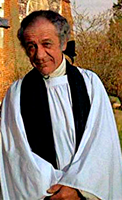
On this occasion we arrived unavoidably late at the church, although this was only about ten minutes or so. The church was open but the Vicar was not there. Outside was a van, the driver being a carpenter (I think) who was
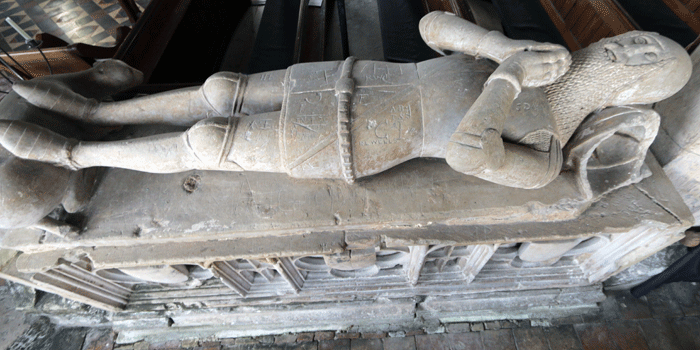 working inside the church. He appeared and told us that the Vicar
had arrived although soon had to leave for another appointment; this was
obviously true if only for her to unlock the church, but she clearly had not mentioned to
him that we were coming. Even though this man was actually working
inside the church and I was carrying cameras and their accessories, he
was very reluctant to allow us inside; he clearly did not realize that
he had no legal right to prevent us from entering as we held written
permission from the incumbent to do so. As I have said, the church was very
isolated but he told us that thieves often travel along the motorway and break
into the church; I was unsure if this were actually true or just a
gross exaggeration, especially as he identified the thieves as that
group of people who are always accused, often with no justification, of such behaviour. I showed him
my bag and what it contained, told him that I had received permission
from the Vicar, giving her full name of course, and alluding to the fact
that her husband was also a cleric in the team. My wife also told
him that she was a churchwarden so quite understood any problems
associated with churches. I also showed him the
e-mails we had exchanged. He eventually allowed us to enter, although
somewhat grudgingly, when we told him in exasperation that he would be
there all the time to keep eye on any possible misdeeds. He also saw
that we were quite clearly not going to go away. His obstructive and
ridiculous attitude
did improve when I began taking the photographs.
working inside the church. He appeared and told us that the Vicar
had arrived although soon had to leave for another appointment; this was
obviously true if only for her to unlock the church, but she clearly had not mentioned to
him that we were coming. Even though this man was actually working
inside the church and I was carrying cameras and their accessories, he
was very reluctant to allow us inside; he clearly did not realize that
he had no legal right to prevent us from entering as we held written
permission from the incumbent to do so. As I have said, the church was very
isolated but he told us that thieves often travel along the motorway and break
into the church; I was unsure if this were actually true or just a
gross exaggeration, especially as he identified the thieves as that
group of people who are always accused, often with no justification, of such behaviour. I showed him
my bag and what it contained, told him that I had received permission
from the Vicar, giving her full name of course, and alluding to the fact
that her husband was also a cleric in the team. My wife also told
him that she was a churchwarden so quite understood any problems
associated with churches. I also showed him the
e-mails we had exchanged. He eventually allowed us to enter, although
somewhat grudgingly, when we told him in exasperation that he would be
there all the time to keep eye on any possible misdeeds. He also saw
that we were quite clearly not going to go away. His obstructive and
ridiculous attitude
did improve when I began taking the photographs.What a Carry On!
| Totally Irrelevant Notes |
That is Sid James playing a dubious parson in Carry on Dick: there was never a Carry On Vicar, although perhaps that would have been a 'Good Thing'. I can see the cast now.... |
Occasionally we read on a church monument that the commemorated had left a legacy to the church. This information is often found on the simplest of brasses and records such a legacy being left to the church in order to recast a bell, to repair an organ, the roof, to install electric lighting, or to insert a new window; occasionally it is even for major construction work in the church. Similar information also occurs from time to time on tablets which are not strictly church monuments at all, so I have usually not recorded these.
It might be said - and not entirely unfairly - that these are descendents from similar bequests which occurred in the Middle Ages when the very wealthy left a large legacy in their wills to construct a chantry chapel for themselves, often containing a tomb chest and effigies, and always containing an altar. The legacy also paid for a priest or priests to say masses for them for evermore to ease the passage of the legators' souls through Purgatory. In effect you could buy an express ticket to heaven, or so they genuinely believed. The poor did not have access to this privilege, instead they had to pay a different sort of price. But so it is and has been in all aspects of life.
Unfortunately 'for evermore' did not last all that long, Purgatory was abolished and a more equal, fairer and more Christian form of Christianity prevailed. A privileged lifestyle and a magnificent monument you could still buy in this life but now we all had an equal chance in the next.
Many of these chantry chapels remain today, now empty of priests, but stand as magnificent examples of medieval architecture and the skill of the medieval craftsmen.
There are other similar records of bequests which are often not actual church monuments as such but simply record a will. These are often reproduced on painted boards, Bequest Boards, and record a more humane form of charitable bequest. These often make interesting reading about times past and people's attitudes. I have unfortunately not photographed or recorded any of these as far as I know, at least not systematically. My wife recorded a few which make quite quaint reading as well as showing that times have fortunately passed where such bequests were necessary:
Kilburn Church (Near Kirby Fleetham, North Riding) It is recorded that money was left in the 1700's for one local girl to be taught to read, write and knit.
Wetherfield St Mary Magdelene. A board records the bequest of money to pay a teacher to instruct local poor girls in knitting and sewing as well as their catechism, but also to pay for fuel for the fire.
I will add more as I find them.
I like complicated watches, the type that are called Grand Complication Watches; these watches that tell not only the time but the day, the date, the month as well as the phases of the moon. And - if I could afford such a watch - a mechanical one, naturally - one that would give the year as well, and possibly other information. When watches were all mechanical, such watches were a fabulous price: I recently saw one for sale at €70,000 and that was second hand. This price may well have been because it was second hand in the sense that it was not longer manufactured, rather than in spite of being second hand. I did see a new watch which also told the year in a jeweller's shop in London; I did not bother to even look at the price at that time. I checked recently: it was over €34,000. Phew!
 With the coming of quartz watches, grand
complication watches are now a more reasonable price, allowing many more
people - normal people, you might say - to be able buy one, which I did.
Yes, it's made by a mass watch
manufacturer rather than being hand crafted in Switzerland. But, it uses a
battery rather than one having to perform the tedious bother of
winding it daily. And the local watchmaker can repair it rather than one having
to undergo the
drudgery of personally taking it to its Swiss factory once a
year for a
With the coming of quartz watches, grand
complication watches are now a more reasonable price, allowing many more
people - normal people, you might say - to be able buy one, which I did.
Yes, it's made by a mass watch
manufacturer rather than being hand crafted in Switzerland. But, it uses a
battery rather than one having to perform the tedious bother of
winding it daily. And the local watchmaker can repair it rather than one having
to undergo the
drudgery of personally taking it to its Swiss factory once a
year for a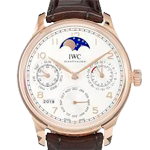 service
taking a week.
service
taking a week.But these batteries can present a problem in that they have to be changed by someone who can change such batteries.
Once it was easy: I worked in a small Devon town which actually had a watchmaker's shop. It had little else, however: the excellent tool shop, the two shoe shops, the butcher's shop, the sports shop, and most of the other shops disappeared to be replaced by a row of charity shops and a ghastly pound shop. A few remained: one of the two chemists, one of those clothes shops which sell fashions of the 1940's and whose window looks like it has not been changed since that time - and Mr Gibbs, the watch maker. Everyone liked Mr Gibbs, who was a true expert in his craft. Otherwise to have my watch battery changed meant a trip to the nearby city where a smart jeweller's shop would take a week to carry out this 'while you wait task' and charge accordingly.
Unfortunately Mr Gibbs died about the time I retired and we moved away from this now shell of a town.
 We moved to a village which had few shops so it is
hardly surprising that there was no watchmaker. In fact most
of the useful shops and services had closed just before or shortly
after our arrival; the garage, a baker, the butcher, the florist, the
bookshop, the chocalatier, the doctor, and an excellent restaurant. But one
shop did remain and people would come
just to see this wonderful shop of a musical instrument maker and
repairer. Outside the shop over the door, rather curiously, hung a very large
model tuba although M. Franc
Huber's specialty was string instruments. There are a few of such
shops around but all they deal with are mundane violins and
guitars. M. Huber's was different: he also included mandolins, lutes,
hurdy-gurdies,
and instruments I had neither seen before nor could recognize.
One resembled a large mandolin but which had drone strings inside
the body; M. Huber told us that it was called a 'mandolin d'amour'.
Unfortunately M. Huber died and the shop has since been occupied by
tradesmen of little interest and less use.
We moved to a village which had few shops so it is
hardly surprising that there was no watchmaker. In fact most
of the useful shops and services had closed just before or shortly
after our arrival; the garage, a baker, the butcher, the florist, the
bookshop, the chocalatier, the doctor, and an excellent restaurant. But one
shop did remain and people would come
just to see this wonderful shop of a musical instrument maker and
repairer. Outside the shop over the door, rather curiously, hung a very large
model tuba although M. Franc
Huber's specialty was string instruments. There are a few of such
shops around but all they deal with are mundane violins and
guitars. M. Huber's was different: he also included mandolins, lutes,
hurdy-gurdies,
and instruments I had neither seen before nor could recognize.
One resembled a large mandolin but which had drone strings inside
the body; M. Huber told us that it was called a 'mandolin d'amour'.
Unfortunately M. Huber died and the shop has since been occupied by
tradesmen of little interest and less use.When my watch battery needed replacing, I took my watch along to the nearest large town to have this done; this town is an empty place, with many shops having closed in recent times, including a very fine book, art materials, DVD shop. Like the English small town these closures were due to increasing rents and rates and limited and expensive parking; in fact the large town has recently installed 'nasty' parking meters where you have to have to add your registration number, so driving more shops and their customers away. The town now seems to sell mainly clothes (not 1940's fashions, however) and food, meaning restaurants and fresh food shops: even the latter are not very satisfactory as the delicatessens have never heard of lampreys or even marmalade. There are a few antique shops, of course, and a couple of jewellers but these are of the glitzy variety, selling watches both expensive and cheap but nothing of special interest, certainly no grand complications. Nevertheless I took my watch to one of these shops and the battery was replaced without any difficulty while we went shopping, the bookshop then still existing. On returning home I noticed my watch was actually running backwards: quite an achievement, of course, but not exactly what I wanted. We revisited the shop the following day and spoke to the same assistant; this man was clearly very experienced in dealing with complaints as he sent an attractive young lady to apologize to me. She took the watch and it was soon returned with time marching forward again.
A couple of years later my watch stopped again, clearly, so I thought, needing a new battery. Outside the above mentioned town is a dreary retail park with, among the other corregated, prefabricated shops, a couple of equally dreary hypermarkets. Inside one of these is a row of independent small shops and kiosks, one of which sells leather goods, repairs shoes but does not sell them, cuts keys, and changes watch batteries; a rather curious combination I always think. The owner took a long look at my watch and then performed the Gallic equivalent of a sharp intake of breath, shake of the head and a: 'Can't do this one, Guv.'
What has this exciting story to do with church monuments? On a trip looking for the latter we stopped at a village near Chinon to visit a relatively small supermarket and there was a proper watchmaker, much larger than Mr Gibbs's shop as this was filled with a number of ticking clocks and watches. A proper watch maker not just a glitzy jeweller who also changes batteries. My watch stopped a while later so along we went. He took the watch into his workshop and later emerged to tell me the battery was fine although a fault had developed but, yes he could repair it although he would have to order a spare part. Two weeks later we were telephoned and told the watch was now working again.
All fixed and running forwards.
And he changed the battery too.
Bristol Cathedral is not one of England's most visited cathedral, in fact it was not even in the top twenty the last time I looked; I think it is fair to say that quite a few people do not even know Bristol has a cathedral at all. This is unfortunat
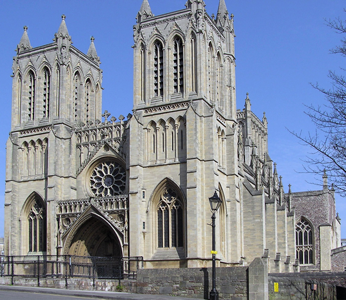 e because Bristol Cathedral is an interesting place and
well worth a visit; for the monument hunter it is even more so for it
has a wide ranging collection, to be sure nothing outstanding, but a
fine collection never the less. And while you're in the City you can also visit The Lord Mayor's Chapel
and St Mary Redcliff.
e because Bristol Cathedral is an interesting place and
well worth a visit; for the monument hunter it is even more so for it
has a wide ranging collection, to be sure nothing outstanding, but a
fine collection never the less. And while you're in the City you can also visit The Lord Mayor's Chapel
and St Mary Redcliff.Bristol Cathedral was not a cathedral at all until as late as 1542, before which date it had been a Augustinian Abbey which had been founded in 1148, but, apart from the much restored chapter house, little of the original Normal church remains today. When Henry VIII dissolved the monasteries the Abbey was spared: he refounded the abbey as a brand new cathedral so ensuring its survival today. The Abbey had been staffed not by monks but by canons regular, that is ordained priests, living under a monastic rule rather like of monks, in this case that of St Augustine; the staff was replaced by canons secular, who did not follow any similar rule, rather similar to cathedral canons today.
We cannot be thankful for many of King Henry's building reforms but, at least, he did not sell the Abbey to one of his cronies to transform it into a mansion called Something Abbey.
As part of the publicity for Dr Clive Easter's Bristol Symposium I visited the Cathedral to photograph the monuments. Bristol Cathedral is a welcoming place: there is no entrance charge and no charge for photography; they do, of course, welcome voluntary donations but there indeed in no pressure on the visitor for this.
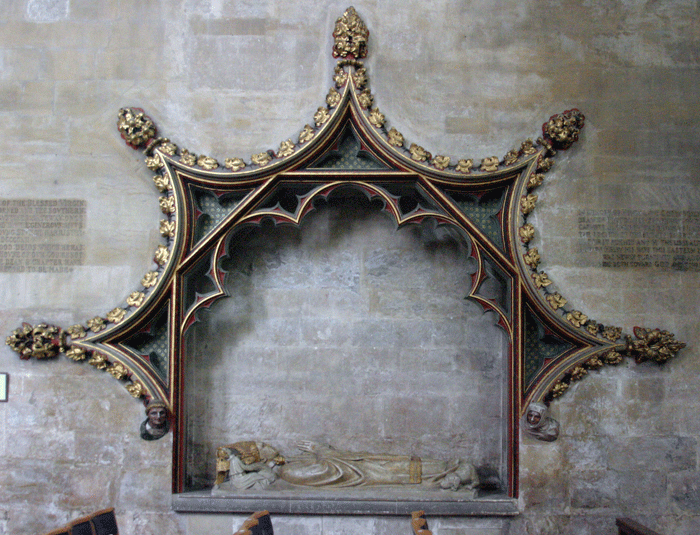 In the walls of the chancel there are three monuments,
with effigies, of three medieval abbots. One of the two in the north
wall - the westernmost one - can be photographed square on (left) but
the eastermost one can only be photographed by entering
In the walls of the chancel there are three monuments,
with effigies, of three medieval abbots. One of the two in the north
wall - the westernmost one - can be photographed square on (left) but
the eastermost one can only be photographed by entering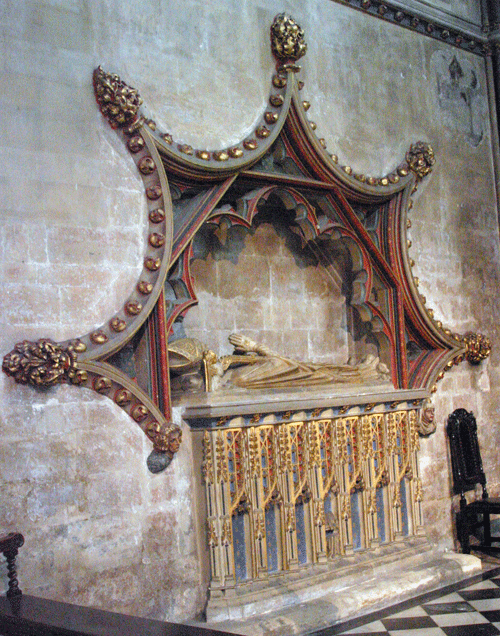 the chancel itself. This latter problem also applies to the single
effigy on the south wall.
the chancel itself. This latter problem also applies to the single
effigy on the south wall.Unfortunately the chancel is roped off and there lies the problem. Many chancels are roped off, some have low rails with a gate, and there has never been a problem. I put one leg over the rope and the foot inside the chancel itself: this not only allowed me too take a photograph from a better angle but also feet apart is the best way to stand when using a telephoto lens in low light. And again unfortunately this set off the alarm: it was only one foot after all. There may have been a notice warning of the alarm but I either failed to notice it or chose to ignore it; after all we often see warning notices of speed cameras ahead but there are no cameras ahead, just the notice, notices being easier and mush less expensive than speed camera.
I looked around: maybe it was someone else; it wasn't. I waited until the inevitable robed figure approached. 'Sorry, it was me...I put my foot over the rope to steady myself ...' He said nothing, just looked at me and walked away. 'O.K. I'll turn the alarm of for ten minutes to give you time to take the photographss,' would have been nice and friendly. But nothing.
So I had to augment my collection with the staright on photograph from a book, shown below, clearly taken before colour photography reached today's sophistication and there were no ropes, alarms, or robe figures; or at least more friendly ones.
Bristol and its churches are well worth a visit but do not step over the rope in the Cathedral.
 |
7. Sling Your Hook
I'm glad to say that the attitude of clergy to those wishing to visit churches just to look around in order to examine the architectural, artistic and historical wonders that churches undoubtedly contain , rather than attending a service, could now
 not be better: one vicar
even happily drove out to a locked church in Yorkshire, for which we had
not asked prior permission to visit, when we telephoned him from
the church yard gate. It has been so at least since the 1970's.
I have only received a far from polite - or even
far from Christian - reception from that church in Leicester (as
mentioned above) and that was when I was in my youth.
not be better: one vicar
even happily drove out to a locked church in Yorkshire, for which we had
not asked prior permission to visit, when we telephoned him from
the church yard gate. It has been so at least since the 1970's.
I have only received a far from polite - or even
far from Christian - reception from that church in Leicester (as
mentioned above) and that was when I was in my youth.An acquaintance of mine - now sadly no longer with us - and a man two decades older than I, recounted a tale of a church he visited where there was a service in progress. He waited until the service had finished and approached the vicar when he appeared, asking if he might enter the church to take some photographs. 'No you may not', said this courteous cleric, 'The church is only open for services and I'm locking it now'. Then he walked away.
My acquaintance was no casual tourist: he was a senior curator at the Victoria and Albert Museum in London and for a period President of the Church Monuments Society in his retirement.
I am afraid I do not know the name of the vicar nor of the church but this was many years ago anyway.
| For those who may not know... 'Sling Your
Hook' has nothing to do with angling as the carton may suggest:
like many excellent and curious phrases, it is a nautical one,
meaning to raise and stow the anchor and sail away. So, 'Sling
Your Hook' is telling some, not all that politely to 'Go Away!'
|
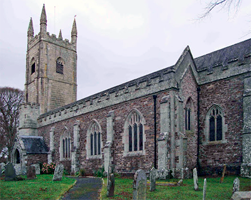 Okehampton Parish Church is
about half a mile out of town and, furthermore, up a steep hill; so it
can be a difficult church to reach for those with mobility problems and
especially so in bad weather. However it has a large and convenient car
park for those fortunate enough to have transport. The church is locked
except during services, of course, as is the toilet, which is
inconveniently situated in the car park. However those with any prior
knowledge will avoid these semi-public inconveniences.
Okehampton Parish Church is
about half a mile out of town and, furthermore, up a steep hill; so it
can be a difficult church to reach for those with mobility problems and
especially so in bad weather. However it has a large and convenient car
park for those fortunate enough to have transport. The church is locked
except during services, of course, as is the toilet, which is
inconveniently situated in the car park. However those with any prior
knowledge will avoid these semi-public inconveniences.The reason for the Church's undeniably inconvenient position is that there was an Anglo-Saxon church, probably a wooden one, on the hill in the same position, surrounded by the original small village. All in an
 easily
defensible position. Following the Norman Conquest, a castle
was built below the hill in the river valley and a village began to
develop in this area, the hill top village being progressively abandoned.
The church remained on the hill top while the town developed below and this is the situation in the
Town of Okehampton today, moving the church to the newly developing
village appears never to have been considered. Because of the inevitable
inconvenience, a chapel of ease was eventually built in the town centre,
considerably smaller than the Parish Church; the former will hold only as many
people as does a side aisle of the latter.
easily
defensible position. Following the Norman Conquest, a castle
was built below the hill in the river valley and a village began to
develop in this area, the hill top village being progressively abandoned.
The church remained on the hill top while the town developed below and this is the situation in the
Town of Okehampton today, moving the church to the newly developing
village appears never to have been considered. Because of the inevitable
inconvenience, a chapel of ease was eventually built in the town centre,
considerably smaller than the Parish Church; the former will hold only as many
people as does a side aisle of the latter.In 1842 Okehampton Parish Church, with the exception of the fine west tower, was destroyed by fire. An excellent opportunity to
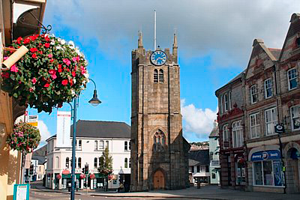 build a new church in the town centre, you might think, with the
tower remaining interestingly situated on the hill top. But no, people are
conservative about such things and church people particularly so: 'it's
always been here so here it must stay' is the attitude, even if
'always' is just a decade. So the inconvenience remained.
build a new church in the town centre, you might think, with the
tower remaining interestingly situated on the hill top. But no, people are
conservative about such things and church people particularly so: 'it's
always been here so here it must stay' is the attitude, even if
'always' is just a decade. So the inconvenience remained.My Wife was Church Warden of this church for two lengthy periods before we moved away from Devon and she suggested to the Vicar that the church be unlocked during the day. This bold suggestion was put before the Parochial Church Council who all agreed that it would be a good idea. There were exceptions with some folk wanting the church to stay locked ('it's always been locked...) but they had no actual authority in the administration of the church at this time. Do you remember the tale of The Little Red Hen from your primary school days? An example of excellent observation of human nature. The Vicar
 and the Council
all agreed that opening the church during the day would be a good thing
but neither the Vicar nor some members of the Church Council wished to be on the rota
that they had suggested for key holders to unlock and lock the church
each day: I suppose we might excuse the Vicar as
he did live 300 yards away from the church. However enough church
goers and at least one none churchgoer agreed to join the rota. I lived five miles from the
church and on Mondays I would perform this hardly arduous task, now
being the proud possessor of the mighty church key.
and the Council
all agreed that opening the church during the day would be a good thing
but neither the Vicar nor some members of the Church Council wished to be on the rota
that they had suggested for key holders to unlock and lock the church
each day: I suppose we might excuse the Vicar as
he did live 300 yards away from the church. However enough church
goers and at least one none churchgoer agreed to join the rota. I lived five miles from the
church and on Mondays I would perform this hardly arduous task, now
being the proud possessor of the mighty church key.Okehampton Church is not a particularly interesting one although the Church does produce a rather good booklet explaining the history of the Church, the Chapel and the Town. I hope it was for sale in more outlets than the Church itself as it would hardly reach the best sellers list, the Church having always being locked to visitors and any member of the congregation who wanted one would have already bought one. I do not think all that many people came, not in the winter months anyway, but is only feasible to count them by the visitors' book; a small number did sign, explaining this was the church were they were christened or where their parents had married.
 One evening I arrived to find a young woman walking down
the centre aisle with her dog but before I could find a suitably
amusing, sarcastic speech to make to here she hurried out of the door. I
mentioned this to my Wife who told me that the Vicar is
sometimes accompanied by his dog in the Church. There must be something about this is
Ecclesiastical Law!
One evening I arrived to find a young woman walking down
the centre aisle with her dog but before I could find a suitably
amusing, sarcastic speech to make to here she hurried out of the door. I
mentioned this to my Wife who told me that the Vicar is
sometimes accompanied by his dog in the Church. There must be something about this is
Ecclesiastical Law! I arrived one morning to open the church and there was a man, who turned out to be a tramp, waiting outside the church. You probably thought you knew exactly what tramps looked like: a little like the cartoon on the left except that the bundle on his stick is usually carried in a brightly spotted handkerchief and the inevitable hat has a flapping crown. William in the wonderful books by Richmal Crompton meets a number of
 tramps on his many adventures but these are often con-men; William's
tramps have now disappeared as they now have jobs in commerce and
advertising. But if you think you could recognize these gentlemen of the
road you would be wrong: this is the age of the Digi-Tramp!
tramps on his many adventures but these are often con-men; William's
tramps have now disappeared as they now have jobs in commerce and
advertising. But if you think you could recognize these gentlemen of the
road you would be wrong: this is the age of the Digi-Tramp!He asked if he might come in and I told him that yes of course might do so. It must have been harvest festival or there was rather a lot of food remaining from yesterday's after service treat because he asked if he might have some food as he was hungry. Again I replied that he might (although I had no authority to do so) but to leave some for others. Then he asked if he might sleep there tonight; I told him that I'm afraid that I had to lock the church but he might sleep in the porch, which has a couple of good sized seats. He then asked if he might charge his mobile phone. Well why not: this is the ago of the Digi-Tramp!
He had gone when I arrived to lock the Church that evening.
Perhaps he was a multi-millionaire testing the hospitality of churches and I might get a mention in his will. No letter from a lawyer has yet arrived but I'll keep you posted.
This rota eventually disintegrated as do many things designed by committee. I would often arrive in the morning to find the Church already unlocked and in the evening to find it already locked, too many holding a key.
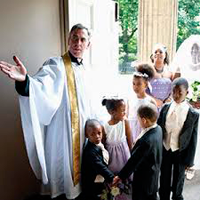 |
Some Notes on the Above |
| 1. The photograph on your left
is not the Vicar of Okehampton. However, he is the vicar (or
rector) of every other church in the country: check this out on
the internet if you do not believe me. He looks very friendly
and welcoming with a come into my church gesture. He seems to
bring a small rent-a-crowd to every wedding he officiates at. We
haven't actually met him yet. 2. Okehampton Church, like all churches has an Harvest Festival. If you think you know where the food goes afterwards, again you would be wrong. My Wife, as church warden, gave the food - with the knowlwdge of the Vicar - to a shelter for the homeless, St Petroc's in Exeter, but, I reget to say, that some of the people who had supplied this food were most annoyed as they wanted it back again for their own use. |
9. No Way In
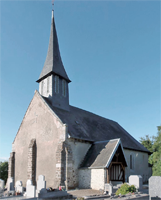 the dwellings were widely separated. All we saw was the church, right,
and across the narrow road a house and what appeared to be a market
garden. We had not written to ask permission to visit and take
photographs in the church, principally because we had no idea to whom to
write. Anyway most churches in France are not locked and the very few
that have not been has a notice on the door giving the telephone number
of the key holder.
the dwellings were widely separated. All we saw was the church, right,
and across the narrow road a house and what appeared to be a market
garden. We had not written to ask permission to visit and take
photographs in the church, principally because we had no idea to whom to
write. Anyway most churches in France are not locked and the very few
that have not been has a notice on the door giving the telephone number
of the key holder.But Friadel church was firmly locked, there was no notice in the porch telling who the key holder might be nor any hidden key. I walked around the church but there was no means whatsoever of access: if there had been another door, and I cannot remember now if there were one, it too was locked. The notice board across the narrow road from the church featured a photograph of the medieval knight's effigy said to be in the church as well as a little information about him. But no telephone number or address of anyone who could let us in.
A man was working across the road in the market garden: but no he did not have the key and no He did not know who might have it. He was not being obstructive as he had a pleasant, friendly enough manner.
One blank drawn!
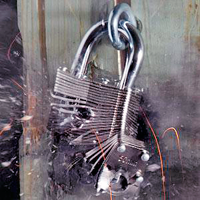 |
'You've seen it in the movies, now
let's see if it's true' Two problems: 1) Your would never get a fire arms certificate, and 2) It doesn't work anyway. There is a way...but here is not the place! Far right...another possibility. |
 |
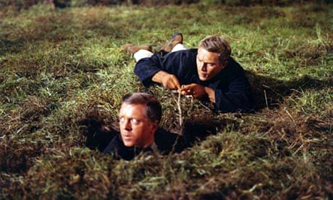 '...errr...weren't we trying to break in?...' |
Brian Kemp it was who used to say how excited he felt if he entered a church he had stumbled upon to find a fine, interesting monument he had not expected to be there. He obviously did not mean the sort the excitement I would have felt if I had received a Number Ten Meccano Set for Christmas as a child, or I would now if I received a seven liter AC Cobra as a birthday present: not that, but more akin to the less transient excitement of finding out: The Pleasure of Finding Out is, in fact, the title of a book by physicist, supreme communicator, bongo player, and lock picker, Richard Feynman.
 I remember that sort of finding out
feeling when I first saw the Plantagenet effigies at Fontevraud Abbey
several years ago. Actually the village where the abbey is situated is called
Fontevraud L'Abbey but giving this full name and then
referring
I remember that sort of finding out
feeling when I first saw the Plantagenet effigies at Fontevraud Abbey
several years ago. Actually the village where the abbey is situated is called
Fontevraud L'Abbey but giving this full name and then
referring to the abbey itself produces a rather silly repetition.
The village used to be called Fontevrault, as it is
in Stothard's magnificent book, and we still that spelling on the odd cast
iron embossed road sign. It changed when,many years ago, a local historian
discovered that the original name was actually Fontevraud, and
so the authorities reverted to this original name; or so I am told.
to the abbey itself produces a rather silly repetition.
The village used to be called Fontevrault, as it is
in Stothard's magnificent book, and we still that spelling on the odd cast
iron embossed road sign. It changed when,many years ago, a local historian
discovered that the original name was actually Fontevraud, and
so the authorities reverted to this original name; or so I am told.I first became interested in effigies when my grandparents to me to Ormskirk church as a child, as I mentioned earlier. I became particularly interested in the Fontevraud effigies when I saw black and white photographs of three of them - Henry II, his wife, Eleanor of Aquitaine and their son Richard I, known as the 'Lion Heart' - in a book in 1970, The Life and Times of Richard I, by John Gillingham, Emeritus Professor of History at the London School of Economics. John Gillingham is that rarity: a professional historian who can write. Later I saw a photograph of Isabelle of Angoulême, who had been the young second wife of King John. They were in various positions: at the far end of the nave, as they are now, lined up in one of the transepts, while in an early photograph they are in a row, standing on end in the cloisters. I later saw colour photographs of the effigies and noted the had been painted; I also noticed that that of Isabelle was somehow different to the other three.
I once had a small book on armour which I had bought from the Tower of London and I believe it was on the back page of the book that there was an illustration of an effigy in armour, which the book said was taken from a book of medieval effigies by C. A. Stothard in which were many beautiful 'engravings'; although they were actually etchings and not engravings. I managed to order a copy of this hefty book from the Library in Guildford, Surrey although I had to remain in the library to look at the wonderful and impressive etchings; the etching were in black and white but many, including those of the Plantagents, were hand coloured or partly so. I eventually bought a copy of Stothard's book myself from Marlborough Rare Books in London from where more than thirty years later I bought a similar book of etchings by Thomas and George Hollis, who had planned to continue the work of Charles Stothard following the latter's premature death in an accident. The Hollis father and son were also to die prematurely, this time from tuberculosis, so their planned work was never completed either.
I had been drawing in pen and ink for several years, mainly of buildings and I discovered that with this technique I could make quite reasonable copies of Stothard's etchings. One day I hoped I could learn the technique of etching and eventually, many years later, I did so, curiously at a studio only a few mile2 from where Charles Stothard had met a fatal accident many years before.
Acquiring information about Fontevraud Abbey was not particularly easy in those pre-internet days but in due course I discovered the Abbey was now a prison. Could I visit it I wondered? The story of the Abbey is in brief thus:-
The Abbey foundation was a singular one, the Order of Fontevraud, being a joint order for nuns and monks; it need hardly be added that they lived in entirely separate quarters. The head of the Abbey was a woman, the Abbess, and she had jurisdiction over several daughter houses, including a few foundations in England. There are other such joint foundations with different command structures but this need not concern us here. The French Revolution brought about, among much else, the dissolution of the monasteries, those were the monks or nuns performed social secular functions - such as teaching or caring for the sick - were the last to be closed. On 1792 the Abbey closed and the nuns and monks dispersed. As ever there was much looting until the local maire ordered that the gates of the abbey be closed. In 1796 the Abbey was bought by a farmer but in 1804 Napoleon acquired the buildings to be used as a prison; by all accounts it was a very harsh prison indeed.
 In 1816 Charles Stothard visited
Fontevraud on one
of his monument seeking expeditions to make drawings of effigies for his
proposed books. How he managed to gain access to a secure prison is
never explained but enter he did. He was delighted to find the
Plantagenet effigies, which
had generally assumed to have been
In 1816 Charles Stothard visited
Fontevraud on one
of his monument seeking expeditions to make drawings of effigies for his
proposed books. How he managed to gain access to a secure prison is
never explained but enter he did. He was delighted to find the
Plantagenet effigies, which
had generally assumed to have been destroyed, in a tunnel in the Abbey;
the Abbey has a number of underground passages. In 1816 he proposed that
the effigies be sent to England for safe keeping but, although central
government agreed, there was much local opposition to this suggestion
and the Prefect of Maine-et-Loire ordered that they be moved into a
disused passage of the cloisters for their preservation. We can be
grateful to Charles Stothard for drawing public attention to the
effigies but thankful that they were not brought to England.
destroyed, in a tunnel in the Abbey;
the Abbey has a number of underground passages. In 1816 he proposed that
the effigies be sent to England for safe keeping but, although central
government agreed, there was much local opposition to this suggestion
and the Prefect of Maine-et-Loire ordered that they be moved into a
disused passage of the cloisters for their preservation. We can be
grateful to Charles Stothard for drawing public attention to the
effigies but thankful that they were not brought to England.In 1846 the monuments were taken to Versailles for restoration and repainting; this work was subject to criticism but if you compare the colours on the late 17th century drawings with those of the early 19th it is clear that this is not the first time that they have been repainted before. At this time presumably Eleanor's book was restored: it had appeared on the earlier drawings but is shown as broken away in the later ones. The kings do not hold scepters in either of the drawings but these were presumably restored at this time; today only Henry holds a scepter while Richard is shown holding a scepter in the earliest of photographs but today it has been removed again. Perhaps they never sported scepters in the first place, or rather not as they were later added.
 |
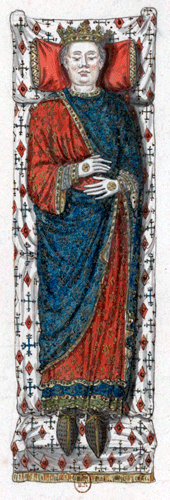 |
 |
 |
In 1866 there was another call, this time in the Pall Mall Gazette, for the effigies to be 'returned' to England, not that they were ever in England in the first place, and moved to Westminster Abbey. They were offered by Napoleon III to Queen Victoria and we can again be thankful that this was never carried out. In 1909 the Abbey was put under the care of the French Department of Ancient Monuments and in 1930 the effigies were displayed all in a line in one of the transepts of the Abbey Church. You will still come upon pictures in books of this rather ungainly arrangement.
During the German Occupation of France the Wermach were stationed in the military camp, a little outside Fontevraud but, it is said, that an SS unit was housed in a building - now used as flats - in the village itself. A number of prisoners - perhaps members of resistance units - were executed by the occupying forces, some in the camp, at least one while trying to escape, but a number in the Abbey complex itself, so a plaque in the grounds recalls.
It was as late as 1963 that the Abbey prison began to be closed, but not yet finally. This otherwise welcomed act caused major problems for the village as the major source of work there was actually related the prison, and the prison itself relied on the village for its essential supplies. There was even a railway taking prisoners to and from their enforced new home; this has now gone although the station situated at the edge of the village where the railway running along the Loire entered the road to the centrally located prison is today a house. Some friends told us recently they visited Fontevraud in the late '60's and then visitors were allowed in the church, the cloisters and the medieval kitchen but nowhere else: nowhere else is were the prisoners still lived and worked. The monuments were then in a transept, the south, I believe. They were shocked to see prisoners in a chain gang going to work in the fields: that is what they do in America while here it is Liberty, Equality and Fraternity surely? Some of the prison did remain housed in the Madeleine Detention Centre - which is within the main walls but in its own secure compound - and they worked clearing the site as part of the major restoration work. The last prisoners finally said goodbye to what had been a prison with a harsh regime in 1985.
My Wife, who had been accustomed to visiting France, took me there on a short holiday, to visit the Bayeux Tapestry and Fontevraud so I might at last see those wonderful monuments. The outer walls and gates of the Abbey gave it a somewhat grim appearance - it had been a prison for many years, after all - but it side was a recent, modern reception area. We arrived but it had closed for lunch for two hours - the French have a habit of so closing, which the English had long forgotten about, so we had to wait until 2.00 to enter; the Abbey no longer closes for lunch but many places still do. We arrived at the reception desk. 'May I take photographs? May I used a tripod? I asked. I remember the nature of the reply if not the actual reply itself, which seemed to say: 'What a foolish question to ask; of course, you may.' I remember being thankful that the ridiculous - and historically foolish - requests to move the monuments to Westminster Abbey had never been carried out: 'No, of course you can't, but will sell you some ' would have been the answer to my question there.
The Abbey Church, called La Grand Moutier, was a rather modest building, especially compared with the church at Caen, where William the Conqueror was buried and which we had visited earlier, and many other soaring churches. It did have a secular appearance and there at the east end of the nave, accessed by a flight of steps, were the four wonderful effigies, a sight I had waited for years to see. I walked around, examined them in every details, took many photographs: this was no mean spirited Westminster Abbey. Yes, Isabelle was, after all, made of wood. The others were of stone the kings were similar (but not exactly so) but very different to Eleanor. There was Henry 'for whom the world was not enough', Eleanor, often foolishly said to be a 'modern liberated woman', rather then a woman of her time from the south, Richard, the much, in more recent times, maligned crusader king, who may have done much more had he not been killed in his early forties, and Isabelle, not so famous but about whom a wonderful story can be told.
At last! Next stop, Queen Berengaria. And another silly story of England wanting her back.*
10. A Lucky Find
If you find a church which is locked and you have not requested prior permission to visit, always look for a notice board which usually - but not always - gives the name(s) and contact details of the key holder(s). The notice board will be in the porch, on the door, inside the lych gate, or on the churchyard gate; failing that look in any nook or cranny or behind a, often cobwebby, notice board in the porch, where a key may be lurking. Do not attack the furniture with a stick, although that may actually work. (see above)
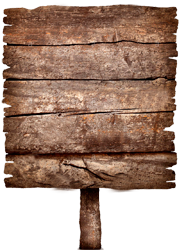 !
!It was when we were travelling to abbey of Saint-Benoît-sur-Loire, also known as Fleury Abbey, for my birthday and where I had planned to take some photographs of King Philip the Amorous, the French King at the time of the Norman Conquest, that we planned to visit another church on the rather long journey and which held a late 15th century effigy of a knight. We arrived at the church but it was firmly locked and there was no notice on the gate, door or anywhere else.
We walked back to the small graveled parking area outside the churchyard gate and noticed there was a old, weather worn, wooden notice board on the gateway, not those sophisticated glass lockable notice boards with a glass window protecting the notices from the weather and vandals (and on occasions from the police when urged to remove an inoffensive notice by their pals), but just a shabby wooden board. We may have noticed it earlier but there was no notice on it so we assumed that it was probably no longer in use. Then my wife spotted something lying on the gravel: it was only a wet and rather muddy plastic envelope but inside was a small notice giving the telephone number of the key holder.
My wife telephoned the key holder and in due course a lady arrived to unlock the church for us. As is invariably the case she was more than happy to open the church for us, even though we had possible disturbed her, and even happier to recount a detailed history of the church.
A successful visit and Fleury Abbey was next on the schedule. So, if there is no notice on the notice board and particularly a weather worn one, always search the ground too: eyes down for the next church!
11. Church, What Church?
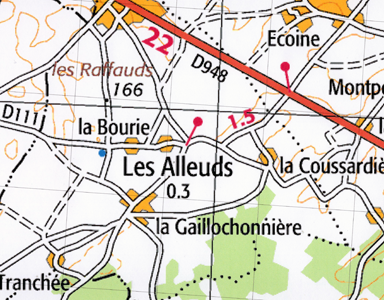 The 'List' I often use to find the
whereabouts of French effigies clearly states that there is a
14th century
stone effigy of Abbot Guillaume, who died in 1318, to be found in
Abbaye Notre-Dame at Les Alleuds. This commune,
it further states, is in the
départment of Deux-Sèvres in
the old région of Poitou-Charentes. Les Alludes
is quite clearly marked on the 1:100,000 IGN map of the area
but it is only shown as a small hexagon, which appears to be the
standard symbol for the smaller villages or hamlets on maps of
this scale, while the larger villages are shown as a basic outline of the actual
buildings. There are a number of such 'hexagon' villages in the area.
Churches are marked on these maps by a circle with a cross on the top, rather like that for 'church with spire' on the Ordnance Survey
(O/S)
maps. However no church at all is marked, which is
rather curious, this being listed as an abbey church.
The 'List' I often use to find the
whereabouts of French effigies clearly states that there is a
14th century
stone effigy of Abbot Guillaume, who died in 1318, to be found in
Abbaye Notre-Dame at Les Alleuds. This commune,
it further states, is in the
départment of Deux-Sèvres in
the old région of Poitou-Charentes. Les Alludes
is quite clearly marked on the 1:100,000 IGN map of the area
but it is only shown as a small hexagon, which appears to be the
standard symbol for the smaller villages or hamlets on maps of
this scale, while the larger villages are shown as a basic outline of the actual
buildings. There are a number of such 'hexagon' villages in the area.
Churches are marked on these maps by a circle with a cross on the top, rather like that for 'church with spire' on the Ordnance Survey
(O/S)
maps. However no church at all is marked, which is
rather curious, this being listed as an abbey church.Perhaps the scale of 1:100,000 is not large enough to include this particular church, although the majority of churches do appear to be marked, and this is an abbey church, after all. The O/S series of maps with the scale of 1:50,000 are just right for my particular purpose, but IGN, which may be said to be equivalent in form to the O/S although by no means of the quality, do not produce maps of this scale. They do produced a 1:25,000 series (as do the O/S) which is a useful 'walking' map, with the footpaths well marked which they are not, in any detail, on their smaller scale map. These latter maps are really too big for what I require.
Although the list is a very useful source for effigies, it does have errors from time to time and there and there are a number of Les Alludes in France. In the multi-volumes work on French churches, which sometimes does not give church monuments a particular high priority, Les Alludes is listed, as is the church, with the effigy, and, most importantly, it is in Deux-Sèvres. There is also no other Les Alludes in this départmente.
My wife has one of those mobile phones which can do anything: anything includes producing a series of Google maps, with Sat Nav facilities, as well the satellite view of the area and there is the church, clearly marked Abbaye Notre-Dame, just outside the village of Les Alludes. Why is it then not included on the IGN map?
We found Les Alludes with no difficulty and there was a rather small sign pointing up a narrow road stating merely église. There was another small sign, this time a road name, reading Abbaye Impasse. Impasse actually means 'dead end', although
 there is no equivalent word in English, Abbey Dead End
not creating the right impression. At the end of this short road
was a car park and there was the church which was firmly locked with no
indication from where to obtain the key; in fact there were no notices
at all on or besides the church door. At one side of the church was an
unsightly, solid lockable metal gate leading to the church yard; this
was not locked so I wandering around the church yard and then back to
the car park via a better styled gate on the opposite side There was one small door on the
south side of the church but this seemed actually sealed rather than locked.
there is no equivalent word in English, Abbey Dead End
not creating the right impression. At the end of this short road
was a car park and there was the church which was firmly locked with no
indication from where to obtain the key; in fact there were no notices
at all on or besides the church door. At one side of the church was an
unsightly, solid lockable metal gate leading to the church yard; this
was not locked so I wandering around the church yard and then back to
the car park via a better styled gate on the opposite side There was one small door on the
south side of the church but this seemed actually sealed rather than locked.The church yard, hedges surrounding the car park, grass, gravel and the area in general were well cared for. There were some steps near the church leading to a crypt, although the crypt itself was closed by a grill, and again all was in well maintained order. This was clearly not a disused church. Then we noticed one exception to this general neat and tidy atmosphere: attached to a shed at the entrance to the car park was a notice board, one of those glass fronted type that can be opened. The wood work was faded, the paint peeling, and the glass rather dirty. The faded notices were of the usual type but did include the e-mail address of the curé; there were, oddly, no services listed and the notices clearly had not been changed for over six months. We stayed for a picnic lunch in the car during which time one other car appeared: the occupant was visiting the church yard but did not know anything about visiting the church. No one else arrived.
The village, which turned out to be classified as one of a series of small communes dependant on a larger commune, was indeed a very small one but did have a marie annex staffed one afternoon per week, but not the afternoon we were there, of course. The actual marie was probably in the principal commune, and send staff out to these annexes one session per week.
Those of a conspiratorial state of mind could certainly read something into all this but I shall leave them to speculate!
12. Best Viewed from Outside
 In sharp contrast to Les Alludes, the
Abbaye Royale of Celles-sur-Belle, which is also in
Deux-Sèvres, appears to be positively eager for you to visit. The
' Royal Abbey' is well shown
on the IGN 1:100,000 map as a red open circle with a cross on top. Such open
circles with crosses represent churches and when they are red it means they are on the
tourist trail, or at least deemed worth a visit; other churches are black.
The words on the map Anc. Abbaye does not mean, as you might
expect ancient abbey but rather former abbey; likewise
the term ancien professeur means not, as originally thought, an
ancient professor (like Professor Binns) but a former teacher.
In sharp contrast to Les Alludes, the
Abbaye Royale of Celles-sur-Belle, which is also in
Deux-Sèvres, appears to be positively eager for you to visit. The
' Royal Abbey' is well shown
on the IGN 1:100,000 map as a red open circle with a cross on top. Such open
circles with crosses represent churches and when they are red it means they are on the
tourist trail, or at least deemed worth a visit; other churches are black.
The words on the map Anc. Abbaye does not mean, as you might
expect ancient abbey but rather former abbey; likewise
the term ancien professeur means not, as originally thought, an
ancient professor (like Professor Binns) but a former teacher.There are numerous Royal Abbeys in France, mostly with only the most tenuous connection with the French (or any other) royal dynasty; I expect Royal is meant to give the impression that they are rather grand. However, it is totally meaningless since L'Épau Abbey, near Le Mans, contains not only the monument, but the actual remains, of Queen Berengaria of Navarre, queen of King Richard the Lion Heart, yet receives no such royal designation.
Again in sharp contrast to Les Alludes the commune of Celles-sur-Belles and its Abbey are very well signposted indeed; you really cannot take a wrong turning. The commune is indeed a delightful place to visit and the abbey church rising about the village an impressive sight. Parking is free and there is at least one car park only a short walk away from the abbey itself.
The
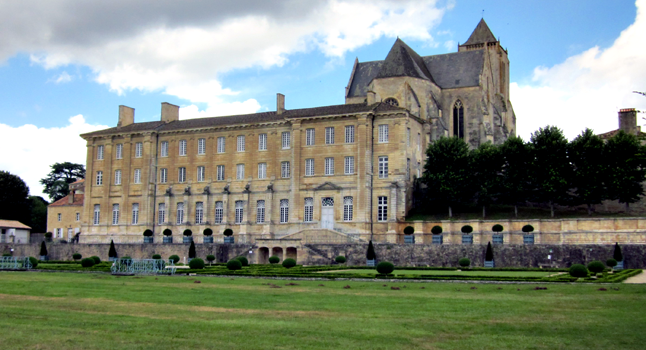 Abbey of
Celles-sur-Belles itself was first built in the 12th
century but rebuilt in the 15th on the order of King Louis XI,
which
presumably explains the royal designation. It was partly destroyed during the
Religious Wars of the 16th and then rebuilt in the 17th century. It was closed during
the French Revolution, when the monks were ejected, and then had a rather
checkered history, being used as a prison for a while, until in 1801 the
church itself became the parish church. All is now owned by the commune
of Celles-sur-Belles.
Abbey of
Celles-sur-Belles itself was first built in the 12th
century but rebuilt in the 15th on the order of King Louis XI,
which
presumably explains the royal designation. It was partly destroyed during the
Religious Wars of the 16th and then rebuilt in the 17th century. It was closed during
the French Revolution, when the monks were ejected, and then had a rather
checkered history, being used as a prison for a while, until in 1801 the
church itself became the parish church. All is now owned by the commune
of Celles-sur-Belles.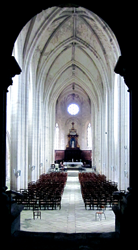 To enter the complex you pass through tall
iron gates and into the garden, shown in the foreground in the
photograph on the right. The gardens are quite free to
visit and well maintained; they are pleasant enough to wander around,
containing a stream with several small foot bridges as well a little seating near the main
buildings. However the buildings are not free and have
opening hours even more complex than usual, as well as closing
for lunch. I will not bore you with the details as I feel
that after reading this short article you will be unlikely to pay
this abbey a
visit at all.
To enter the complex you pass through tall
iron gates and into the garden, shown in the foreground in the
photograph on the right. The gardens are quite free to
visit and well maintained; they are pleasant enough to wander around,
containing a stream with several small foot bridges as well a little seating near the main
buildings. However the buildings are not free and have
opening hours even more complex than usual, as well as closing
for lunch. I will not bore you with the details as I feel
that after reading this short article you will be unlikely to pay
this abbey a
visit at all.To visit the actual 'monument' you have to pay at the ticket office/small shop where an amiable girl dispenses the necessary items; when we there was only one other couple visiting but I hope she manages to keep smiling should things becomes busier. This is a complicated process: first you receive your tickets, although there are a number of tickets, one for each of the features you wish to visit and a combined ticket for all three of them. Then you a given a plan of the complex on which Amiable Girl has to draw the route around the features as it is not at all obvious. Then Amiable Girl dispenses the audio guides and explains how to use them and this is followed by issuing three electronic keys to open the various features, all of which has to be explained. She is French but managed to explain all in excellent Franglais. Amiable Girl then asks for personal identification in case you take away, carelessly rather than actively as they have limited time do the audio guides and electronic keys. Then you have to pay: to visit all three features is €12.00 per person but I will leave you, the reader, to judge if this is good value or not. In summary I should like to thank Amiable Girl, who is not even remotely likely to read this, for being both patient and generally nice! I also hope she is perhaps a student who will return to her studies when the long vacation if over.
| An Explanatory Aside |
| It is partly being British that, when visiting the monks' quarters in an abbey or priory, we expect to see cloisters (ruined or otherwise) with the various communal rooms leading off, all with curious names, such as dorter, frater, farmery, of which it is difficult to even guess the meanings. But in Britain the monasteries were suppressed in the mid 16th century while in France they were not suppressed until the end of the 18th century, at the time of the Revolution, by which time monks no longer lived as they did in the middle ages but were rather living the high life in their own individual cells, rather like in a rather mean starless hotel. Monasteries reappeared in both countries in due course and monks not longer, in either country, lived the medieval ideal, which in any case had been in decline well before they were suppressed in Britain and in France. I do not know how a French visitor would react but there are plenty of monasteries in France - both in ruin and complete - which show this medieval pattern with fraters, dorters and all. |
The first feature to which access is gained by the first key, is the museum which is in the 17th century monks quarters: this, as explained above, was disappointing but the museum was, in any case, rather poor. There was a recreated monk's cell
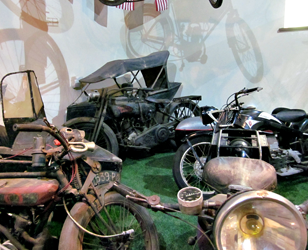 , a
recreated abbot's room and other rather spurious items. The second key
gives access to the abbey church, this is a fine church with the high
vaulting frequently seen in French churches but there is nothing really
exceptional; there are no monuments either, by the way. Yes, I did
write that it was now the parish church, from 1801 actually, so we had just
paid to visit a parish church of which there are many
in France which are quite free to enter and of more interest. As
the titles says, Best Viewed from Outside.
, a
recreated abbot's room and other rather spurious items. The second key
gives access to the abbey church, this is a fine church with the high
vaulting frequently seen in French churches but there is nothing really
exceptional; there are no monuments either, by the way. Yes, I did
write that it was now the parish church, from 1801 actually, so we had just
paid to visit a parish church of which there are many
in France which are quite free to enter and of more interest. As
the titles says, Best Viewed from Outside.The original monastic quarters, including the remains of the cloisters, lie in ruin between the two building complexes referred to above and are undergoing some restoration.
The third key takes us from the sacred to the secular: this leads, rather curiously, into a motor cycle museum. I am vaguely interested in motor cycles and here is a good, although rather jumbled, collection with some famous names, some of which seem to come from the past, such as BSA, Triumph and Norton as well as early examples of Harley-Davidsons. There was curiosity of long ago consisted of what was virtually a pedal cycle with an engine mounted in front of the rider and over the front wheel. The transmission did not involves chains, belts or gears but rather a small wheel turned by the motor rested against the front tyre so turning the front wheel by friction. No, it didn't catch on!
And that was it!
We have not yet found a church monument in a hotel, although it is not impossible that the day might come; we have however visited some curious hotels on our travels around France
We were returning from a trip to Normandy and arranged to stay Sunday night at Falaise, where Williams the Conqueror's father had been a tanner. We had stayed some years earlier there in an excellent hotel which produced the most
 magnificent breakfast ever,
certainly not the occasional, miserable croissant and coffee but one fit for a
king, and a gluttonous one at that. However on this visit this fine place was closed for the winter,
or maybe some other reason, so we booked by telephone a hotel on the
main street in the centre of town.
magnificent breakfast ever,
certainly not the occasional, miserable croissant and coffee but one fit for a
king, and a gluttonous one at that. However on this visit this fine place was closed for the winter,
or maybe some other reason, so we booked by telephone a hotel on the
main street in the centre of town.We arrived in good time and parked in one of the many parking areas along the street and right outside the hotel. The hotel looked closed: the door was closed, the windows were all in darkness, and there was no coming and going or any movement whatsoever; furthermore, the door was firmly locked and there was no door bell. There was, however, an intercom by the door and my wife, who speaks far better French than I do, as well as being able to hear better above disturbing traffic noise, pressed the button and a disembodied voiced asked my wife, after she had given our details, to key in a number on the intercom. This she did, there was a click and we were able to open the door. The entrance foyer was all in darkness until a light automatically turned itself on. On our left was a closed serving hatch, presumably to reception or an office; on a small shelf on front of this hatch was a key and a sheet of paper which proved to be a receipt for our prior payment. On our right was a closed glass door to a dining room; all the tables were set for a meal but there was not a soul there. We never discovered the source of the disembodied voice.
Our room was on the top floor, rather annoyingly as the hotel gave all the appearances of being quite empty: perhaps they start booking from the top down. There was no lift: what appeared to have been a lift had been converted into a service lift for beddings and the like. We climbed the stairs, the lights turning themselves on and off all the way and the key fitted the room which had been allocated to us. It was one of those hotels that you find from time to time in France: a large room, quite clean and well appointed but sad and shabby, clearly having seen better days, as the expression goes. The bathroom was very large, especially for a hotel, and all the plumbing functional; I have stayed in hotels where you can sit on the loo, wash your hands in the basin and your feet in the shower tray all at the same time, but this was far from one of them. All the bed lined and towels were there, freshly laundered and of good quality, not those towels that have become almost transparent (and useless) through years of use and should have been discarded decades ago.
We then did something that should never be done: left the hotel to look for something to eat on a Sunday evening in France! All the bakers, restaurants and anywhere where it was possible to eat or at least buy something to eat were firmly closed. There is one curious fact I have found about 'eateries' (an excellent word that has no satisfactory synonym) in France: even the meanest looking - those you would not even consider walking past in England - frequently serve excellent food at a very reasonable prices. But the place we found was certainly not one of those, neither in appearance nor quality of food: it was a middling sort of restaurant of a middling sort of appearance but it served one course that was a fatty, glutinous mess, the very thought of which still serves as an excellent appetite suppressant. What was it? The menu seemed to say something quite acceptable but that had been taken by the waiter, so I cannot watch out for it in future.
We spent a comfortable night and made our way downstairs in the morning. There was still nobody around: no other guests, no hotels staff, nobody; the hatch was still closed and the dining room was still set for a meal but empty. So no breakfast at all in contrast to the other hotel in Falaise in which we had stayed a while earlier.
Curiously I should like to return one day.
This obscure title refers to church monuments that, for some reason or other, are no longer in churches; rather they are now in museums, private houses, built into external walls, or even in a building that used to be a church but is not strictly a church any longer. Mostly this movement is carried out for the best of reasons but in other case the reason may be a far from ethical one. I will describe some of the reasons and places here.
MUSEUMS are by far the commonest places to find church monuments other than churches themseves. The knight's head on the left was excavated at the site of the Dominican Friary in Exeter, Devon and is now on display in the Royal Albert Memorial
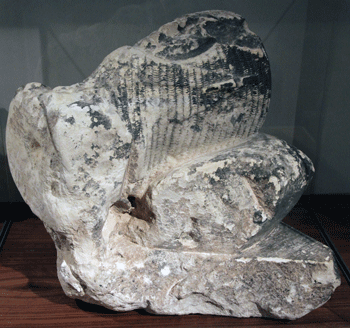 Museum
there. Obviously the best and safest final home
for what is left of a monument to an unknown soldier
Museum
there. Obviously the best and safest final home
for what is left of a monument to an unknown soldier .
On the right is an attractive wooden effigy to an unknown lady in
Barnstable Museum, also in Devon. This effigy found itself in a museum
for an entirely different reason: it used to lie in a niche in Saint
Peter's Church, Tawstock, nearby, but this church - a most interesting
one with many monuments - is in a very isolated position and has a large
car park. There had been a
number of thefts of church monuments (and, sporadically, still are):
wooden effigies are light and easy enough for a thief with a van to
transport, with little chance of being
caught. This is presumably why the lady now lies safe and secure in a
museum glass case.
.
On the right is an attractive wooden effigy to an unknown lady in
Barnstable Museum, also in Devon. This effigy found itself in a museum
for an entirely different reason: it used to lie in a niche in Saint
Peter's Church, Tawstock, nearby, but this church - a most interesting
one with many monuments - is in a very isolated position and has a large
car park. There had been a
number of thefts of church monuments (and, sporadically, still are):
wooden effigies are light and easy enough for a thief with a van to
transport, with little chance of being
caught. This is presumably why the lady now lies safe and secure in a
museum glass case.While on the subject of theft, whatever happened to all those monuments in abbey churches at the Dissolution of the Monasteries? In some cases the former abbey became a secular cathedral, or the abbey, already a cathedral, was refounded as a secular one. In either case the monuments mostly survived. An example of the former is Bristol Cathedral and the latter Canterbury Cathedral. In other cases part of the buildings - often just the church or even the nave - was bought by the town in which it was situated; Tewskesbury Abbey (now a parish church) is an example of this. Sometimes the church was already in part use as a parish church so the parish must have been most annoyed at having to buy back what they already considered their own; rather like in more recent times 'our' post office being sold off to private individuals. Many monastic lands were sold by King Henry to the wealthier subjects and the buildings turned into private houses; often the churches fell into decay, were looted, or the monuments simply thrown out and used as building material. Sometimes the monuments were moved to parish churches while sometimes they were buried in the rubble of demolished buildings to come to light in more recent times in excavations, like the knight's head above.
 From the small museums to the big ones:
From the small museums to the big ones:The Victoria and Albert Museum, London, has a large number of church monuments on display. Many of these were obtained from churches both in Britain and other parts of Europe, often churches which were scheduled for demolition,
 being in a very decayed state, or churches that had become redundant. A
few were from excavations of monastic sites. Sometimes the sale and
transfer of these monuments did not go as smoothly as one would have
wished. To the left is the effigy of Don Garcia de Osomo (1502) from a
church in Spain. Others were not in the strictest sense of the
definition of church monuments, church monuments at all: rather they are
copies, either plaster casts or electrotypes of monuments that are
still, mostly, in the church of origin. To the right is a plaster cast
of the monument of Richard I, which is at Fontevraud Abbey in France.
More of these V &A monuments may be found on a page devoted to that museum
as well as how and why these casts were made.
being in a very decayed state, or churches that had become redundant. A
few were from excavations of monastic sites. Sometimes the sale and
transfer of these monuments did not go as smoothly as one would have
wished. To the left is the effigy of Don Garcia de Osomo (1502) from a
church in Spain. Others were not in the strictest sense of the
definition of church monuments, church monuments at all: rather they are
copies, either plaster casts or electrotypes of monuments that are
still, mostly, in the church of origin. To the right is a plaster cast
of the monument of Richard I, which is at Fontevraud Abbey in France.
More of these V &A monuments may be found on a page devoted to that museum
as well as how and why these casts were made. In France the Louvre museum in Paris has a large
collection of original church monuments, often very fine ones indeed;
these came from demolished churches, often monastic ones, there being
wholesale destruction of such churches during the Revolution of the late
17th century. It might be said that this was in some way similar to the
Dissolution of the Monasteries in England in the mid 16th century.
However there was a fundamental difference here: the Dissolution was
basically due to the greed of King Henry VIII, who had his eye on
valuable properties he could sell to his wealthier subjects and church
destruction was almost a by-product. It must be added that destruction
of items with the slightest hint of 'popery' were also destroyed, which
is why angels' head are often lopped off when they appear around tomb
chests while human 'weepers' are left untouched. In contrast, the
Revolution was due to the hatred and anger of the people directed at
royalty, the aristocracy, the church, religion and everything that
symbolized them: it was a primary destruction against hated symbols.
There was another difference too. Very little effort was made to
preserve church monuments at the Dissolution, although occasionally a
descendant would clearly move the monument into a parish church. Whole
churches were saved when abbeys became secular cathedrals, such as in
Bristol, or when a religious building, or part of it, became a parish
church, as at Tewkesbury. Church monuments were of little regard as
works of art or of any historical value. In France over 200 years later
many people did and attempts were made to salvage church monuments and
even create museums for them, realizing that such monuments were indeed
works of art and valuable historical artifacts, and not the people
themselves. Perhaps we should remember that today.
In France the Louvre museum in Paris has a large
collection of original church monuments, often very fine ones indeed;
these came from demolished churches, often monastic ones, there being
wholesale destruction of such churches during the Revolution of the late
17th century. It might be said that this was in some way similar to the
Dissolution of the Monasteries in England in the mid 16th century.
However there was a fundamental difference here: the Dissolution was
basically due to the greed of King Henry VIII, who had his eye on
valuable properties he could sell to his wealthier subjects and church
destruction was almost a by-product. It must be added that destruction
of items with the slightest hint of 'popery' were also destroyed, which
is why angels' head are often lopped off when they appear around tomb
chests while human 'weepers' are left untouched. In contrast, the
Revolution was due to the hatred and anger of the people directed at
royalty, the aristocracy, the church, religion and everything that
symbolized them: it was a primary destruction against hated symbols.
There was another difference too. Very little effort was made to
preserve church monuments at the Dissolution, although occasionally a
descendant would clearly move the monument into a parish church. Whole
churches were saved when abbeys became secular cathedrals, such as in
Bristol, or when a religious building, or part of it, became a parish
church, as at Tewkesbury. Church monuments were of little regard as
works of art or of any historical value. In France over 200 years later
many people did and attempts were made to salvage church monuments and
even create museums for them, realizing that such monuments were indeed
works of art and valuable historical artifacts, and not the people
themselves. Perhaps we should remember that today.Incidentally there were two other waves of destruction, although probably much less than is generally thought: in France it was the increasingly vicious Wars of Religion of the 16th century and in England during the Civil War (more correctly the Wars of the Three Kingdoms) of the 17th. In French church guide books it is the Huguenots who cause all the damage whereas in England it is Cromwell's Army. Always Cromwell's army, take note, not that the Army actually was Oliver Cromwell's and the man himself had far better things to do. Serious damage did occur during these upheavals but by far the most severe was during the periods described above.
 |
 |
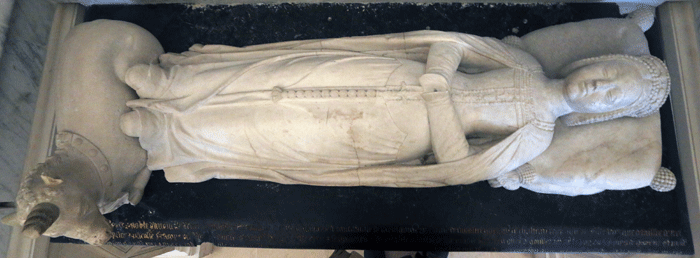 |
|
Church Monuments in the Louvre |
|
If you visit the Cathedral at Rouen in Normandy you will find restored effigies of Richard the Lion Heart and his brother, Henry, 'The Young King', displayed in the choir; you would not have found them 100 or so years ago as they had been ejected and buried in the church. Huguenots, perhaps, or maybe Oliver Cromwell nipped over to France when he wasn't chopping kings' head off! No, this destruction was carried out by the Cathedral authorities in order to 'improve' their church! This origin of destruction is more common than one might think as is general wear and tear.
NO LONGER A CHURCH. The Monastery of Brou has had a checquered history: it was a parish church, then a monastery and funerary chapel, next a prison, then a seminary and is now a museum and visitor attraction. When we visited, there
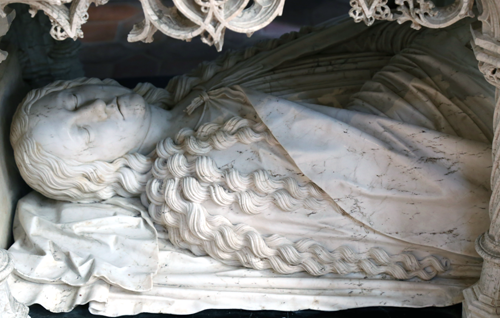
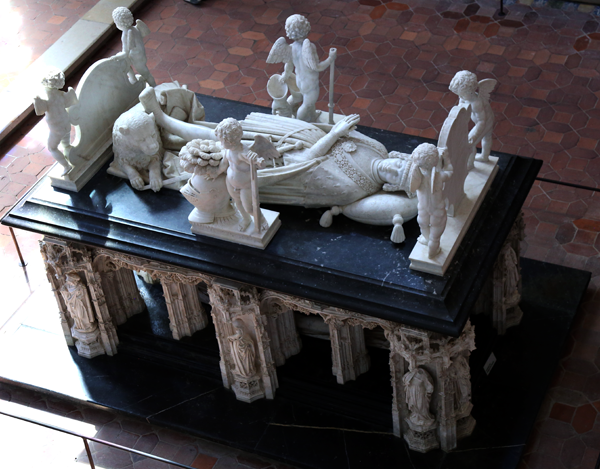 was
an excellent Leggo exhibition in the nave. Unfortunately it has
a commercial atmosphere about it, like no place we have yet
visited, a 'somewhere you must do' feel. Nevertheless it
has three of the finest late medieval monuments around.
was
an excellent Leggo exhibition in the nave. Unfortunately it has
a commercial atmosphere about it, like no place we have yet
visited, a 'somewhere you must do' feel. Nevertheless it
has three of the finest late medieval monuments around.There are other 'used to be churches' that have wonderful early medieval monuments, for example Fontevraud Abbey and l'Épau Abbey, both of which are now cultural centres and no longer working churches although do contain very fine early Plantagenet effigies. Fontevraud Abbey is curious, the four Plantagenet effigies are in the crossing of the church but both the chancel and nave are used for exhibitions, and often rather poor ones at that. Recently a contemporary art exhibition was held in the apse which consisted of stacks of vine cuttings around the walls. Forgive me if I think this form of art is junk, but I am a descendant of the little boy who saw that the emperor really did have no clothes on!. I think this is especially unfortunate and there are plenty of other buildings to hold exhibitions: the church should stand alone.
However none of these other places has the commercial attitude of Brou.
I am told - and I have no idea if this is true or not - that Fontevrau Abbey is no longer consecrated; it was the prisoners' sleeping quarters on extra floors built just for that very purpose for many years, after all. But the Abbey does hold a church service every Easter and, I am told, that the Bishop, who conducts the service, brings along a consecrated stone to make it into a 'proper' church.
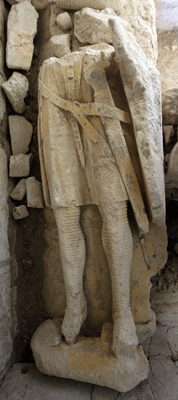 AT HOME. Sometimes effiges may be in someone's
house or garden. Churches are from
time to times simply sold, and often then turned ino private houses. I
am curious to know exactly what happens to the
AT HOME. Sometimes effiges may be in someone's
house or garden. Churches are from
time to times simply sold, and often then turned ino private houses. I
am curious to know exactly what happens to the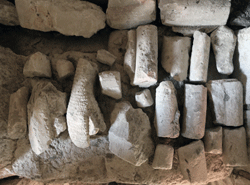 monuments, although these
are often quite small churches with none at all. Sometimes they are
given to museums, which is only right but there is one in France which
is still in the 'church' which is now used as a rather delapidated outbuilding,
other parts of the monastic buildings being used as a private house. At some
time someone had built a wall right across the outbuild so cutting a
knight in two. A lady - presumably his wife - had suffered the same fate
on the other side of this building.
monuments, although these
are often quite small churches with none at all. Sometimes they are
given to museums, which is only right but there is one in France which
is still in the 'church' which is now used as a rather delapidated outbuilding,
other parts of the monastic buildings being used as a private house. At some
time someone had built a wall right across the outbuild so cutting a
knight in two. A lady - presumably his wife - had suffered the same fate
on the other side of this building.Then there are stolen monuments: where do they go? Someone, with more money then ethical standards, presumably employs an expert gang to remove the monuments in an undamaged codition from the church and adds in to his private collection or offers it for sale in his shop. Sometimes - but by no means always - they are recovered although, rather shamefully, the official procedure for doing so may be a complex matter, I am told.
No I have never seen such a one on display in a house: I do not move in the right - or wrong -circles. I have seen the odd flat tomstone used to pave a cellar or a garden but those have arrived there by another form of theft: builders, amateur or professional, having bought or taken what they consider suitable building stones from where is not longer known
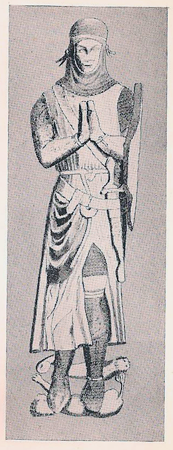 |
ON THE ROAD Occasionally you will find
monuments actually out in the open built into walls, bridges and
elswhere. There is
certainly a knight's effigy, or part of one, set into a wall in the City
of York and a fragment of an effigy in a bridge in Somerset. They are
set in these places for no better reason than they provided cheap
building material at the time. In North Yorkshire there are several
interesting effigies set on the wall of a house which once could be seen
by member of the public; unfortunatley these have now been fenced off
and are no longer accessible. It is a great pity that these effgies
should be exposed to the weather as they are of great interest. My
photographs are damaged but I enclose two of I'Anson's drawings to the
left and right. In Dinan, Brittany there is an effigy of a medieval knight, as shown below, actually in the street, although I have no idea how it ended up there. It is protected to some extent by a canopy. Dinan has a museum of effigies in the cellar of the castle, but this is the only one I have found in actually in the street there. The cellar was a very unsuitable place so these effigies have now been moved to two separate churches in the city. See the section on Brittany. |
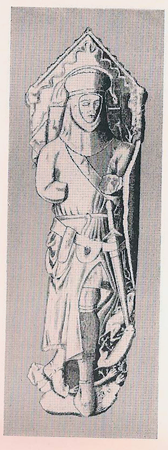 |
 |
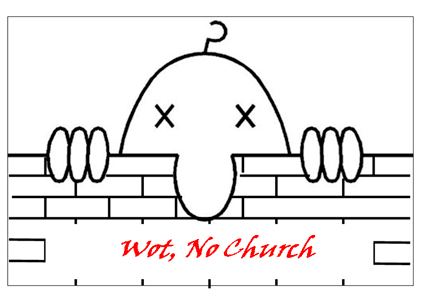 As I mention from time to time, I use
'The List' in order to locate churches in France
with effigies although, unfortunately, this list only points
the way to monuments with recumbent effigies (gisants); any others have to be sought
elsewhere. Usually the List is correct and then I find
the actual commune by a search facility on a 1:100, 000 I.G.N. map on my
computer; this is a very pedantic search engine in that the name of the
commune must be exactly right, exactly right, that is, according to the
search engine, as it will not hazard a guess as happens in Google. Is it, for example,
St Malo, St. Malo, Saint Malo, Saint-Malo, St-Malo, St.-Malo, or even Malo St; I can never remember
which it is but
it is only one of those; no variation will even be guessed at.
Another
silliness is that is it Segré or Segre: the place name
has the accent and the map is a French map of French place. But you
can't type é into the search engine does not recognize accents
at all.
Anyway, the List told me that there was a 16th century gisant
of one Thibaut de Ravennes in the church of Sainte-Eugénie
in the commune of Saint-Eugène in the
département of Allier in the région of Auvergne. Don't ask me
why the saint seems to change gender going from commune to church: it
may be an error in the list or, perhaps, he, or she, just does.
As I mention from time to time, I use
'The List' in order to locate churches in France
with effigies although, unfortunately, this list only points
the way to monuments with recumbent effigies (gisants); any others have to be sought
elsewhere. Usually the List is correct and then I find
the actual commune by a search facility on a 1:100, 000 I.G.N. map on my
computer; this is a very pedantic search engine in that the name of the
commune must be exactly right, exactly right, that is, according to the
search engine, as it will not hazard a guess as happens in Google. Is it, for example,
St Malo, St. Malo, Saint Malo, Saint-Malo, St-Malo, St.-Malo, or even Malo St; I can never remember
which it is but
it is only one of those; no variation will even be guessed at.
Another
silliness is that is it Segré or Segre: the place name
has the accent and the map is a French map of French place. But you
can't type é into the search engine does not recognize accents
at all.
Anyway, the List told me that there was a 16th century gisant
of one Thibaut de Ravennes in the church of Sainte-Eugénie
in the commune of Saint-Eugène in the
département of Allier in the région of Auvergne. Don't ask me
why the saint seems to change gender going from commune to church: it
may be an error in the list or, perhaps, he, or she, just does.We spent a week touring Auvergne (magnificent part of France but the food and wine certainly not to my taste) so we decided to look for Saint-Eugène. Curiously the map search did not take me to the commune itself but kept sending me to Saint-Séverin instead. There was such a place in Allier so perhaps Saint-Eugène was nearby: perhaps it was the church actually marked there, or perhaps the map was wrong rather like the church at Les Alludes, which was not marked at all, as discussed above. So we headed for Saint-Séverin as Saint-Eugène was not listed on the Sat Nav either - but it was listed on Google maps on my wife's phone, everything is.
So we followed the American drawled directions given by this phone and in Saint-Séverin was found a signpost pointing down a narrow, winding, descending road and with Saint-Eugène clearly written on it. We then came to a place sign, again with Saint-Eugène clearly written: we'd found it! It took but a few minutes to slowly drive through Saint-Eugène and then we reached a more major road. We drove back very slowly through Saint-Eugène to Saint-Séverin where we could see Saint-Eugène quite clearly from this higher ground: there was no church, not even the most ruinous of ruins of one but just two houses: this was Saint-Eugène but it was the wrong one. My wife's clever phone can access the internet which told us there were three such names places in France, one with a church with a gisant, but it wasn't this one.
So the list was wrong and I did not spot it!
British roads and French roads are different: nor only do the French drive on the right side (or, perhaps, now the U.K. is no longer a member of the E. U. that should be the wrong side!) but the majority of French roads are in
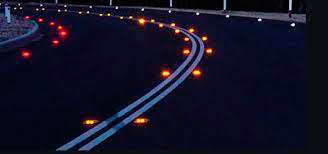
 a far better general state of repair than their British
counterparts. A few are far from perfect, of course, but none have those
tyre tearing and suspension wrecking pot holes and long cracks where
sections of the road have separated along the centre or at the edge,
all this even on major roads. They French roads were built well and are
maintained well: your suspension is safe.
a far better general state of repair than their British
counterparts. A few are far from perfect, of course, but none have those
tyre tearing and suspension wrecking pot holes and long cracks where
sections of the road have separated along the centre or at the edge,
all this even on major roads. They French roads were built well and are
maintained well: your suspension is safe.Come the night and it is a different story: French roads are not a happy place on which to drive in the dark. For a start, there are no cat's eyes anywhere on (or is it 'in'?) French roads, not on minor roads, major roads, or even motorways; not a cat's eye in sight. To make matters worse the paint the French use for the white lines must have been a seconds batch bought in a closing down sale at Woolworths: they are quite clear and bright enough for a few day but then they fade to a road colored gray. So do not drive at night in France if you can at all possible avoid it.
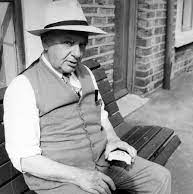 |
| Percy Shaw (1890-1976) The Yorkshireman who invented cat's eyes |
Let's talk about maps. Ordnance Survey maps are excellent, in fact according to friend, they are the best in the world; but then he did used to work for that organization. In all fairness this is the opinion of all those who write about maps and mapping. Travel writer and a man who will always notice the quirky, Bill Bryson has some funny stories to tell about the vagaries of American maps. O/S feel right (they felt even better when they were printed on cloth, now long gone), the printing is clear, and the symbols and the various marking have been very well thought out for the job they do. Motorways are marked by blue roads but not so blues that you might end up in a river and indicated by M_. Trunk roads and major roads are designated by A_ but the former is green and the latter red. Things do change - and improve - over the years: I remember motorways, trunk roads, and major roads all being red by they were designated by M_, A(T)_, and just A. Secondary roads are brown and designated by B_. Minor roads are yellow and tracks are white and neither have an actual designation. At one time these yellow and white road were shown at different thicknesses indication the degree of metalling: if you do not know what metalling is, as I didn't until ten minutes ago, click here. You do not need to read the whole article!
Churches are easy to spot: as for as it can remember they have always been marked by a black square with a cross on top if there's just a tower, a black circle with a cross on top if there's a spire and if neither, it's just a cross. I know spires are usually on top of towers (then it's a steeple) but it is a good way of church spotting.
If you wonder why these maps are called Ordnance Survey maps (not ordinance note: that's something different) check here. The best scale for generally driving around is that of 1:50,000: there is enough clearly marked detail for most purposes and they are not too big to handle either. The French equivalent to the O/S maps are their IGN maps: those initials stand for the National Geographical Institute. I know it's the wrong way round but French does seem to mix words up. Unfortunately IGN do not produce maps at the scale of 1:50,000 so for my purpose I use their 1;100,000 series which is not quite as satisfactory. Both the O/S and the IGN produce maps at the larger scale of 1:25,000 but these are better for walking rather than driving. I have a few of these paper maps but the whole of France and Britain, in the two most suitable scales, on is a computer disc so I can print adequate copies for small areas.
French roads have there designations too: first of all there are A_ roads but these are not the same as British A roads. A roads are autoroutes, or British M roads as you might have guessed, although they are red. The next part is not so easy: there are also E, N, D, and C roads, and these initials bear nothing at all to the ways the roads are coloured. In fact it is a separate system altogether. We do not have E roads in Britain because you cannot drive (except by Eurotunnel, of course) to another country. E roads are European roads and are also M and N roads: I expect when they pass into Germany or Spain they retain their E classification but then adopt the country's classification as well. The other letters stand for National, Department, or Commune, the authority who is responsible for that particular road. Did you guess it?
The IGN maps just do not feel quite right: it's probably the paper they are printed on. The road on the paper maps are marked thus: motorways (autoroutes) are red; principal roads, brown; secondary roads yellow; and minor roads, white. On slightly older maps this used to be different. The marking on my computer maps are similar but motorways are blue; if you try following a thick blue line on the paper maps, well, you can't as it's a National Park boundary.
Church symbols do not distinguish between towers and spires and they are marked differently on the paper and computer maps. On the road maps they are marked by an open white circle with a cross on top on a rectangular red background; this latter, although it makes the them easy to spot on the map, does cover up more detail than it should. They may be marked cath, chap or abbaye to give further information. On the computer they are marked differently: open circles (that is, filled in with white) with a cross in top, if red, refers to a historic church but if black, to any other church. A solid circle if black refers to a chapel but, if red, to a chapel of interest. I have to add, whatever this adjective actually mean! Ruined abbeys, like Cluny, and still existing abbeys, like Fontevraud, both received a church symbol with Anc Abbey. Anc. does not, as English speakers might expect, meant ancient but rather former.
Saint-Priest-Bramefant, in the Puy-de-Dôme Département of the Auvergne Région, does not, it is fair to say, have a particularly attractive parish church, although it does contain an effigy. This is made of a very coarse
 limestone, now worn to little more than a
hulk. But the completist in me says I must 'collect' it.
The church has a large car park but all its doors were locked when we
arrived.
limestone, now worn to little more than a
hulk. But the completist in me says I must 'collect' it.
The church has a large car park but all its doors were locked when we
arrived.The mairie was next door to the church and we had arrived more or less at lunch time. Mairies are the hub of the commune, no matter how big or small (except if the commune is a town when it becomes a Hôtel de Ville, which is the Town Hall, not as might be thought, the town's rather superior hotel!) Le Maire is a VIP in each commune and the person who actually runs the commune; the livre stops at le maire! It is an elected post but the maires do not received the fat salaries like those paid elected mayors do in England; it is often more of stepping stone to higher office, as those who remember the comedy Clochemerle will recall. While we are on the subject of maires note that it's le maire never la maire so a maire who happens to be a woman is Madame le Maire! I do hear that this might be rationised one day.
Anyway the mairie was next door to the church. Mairies, especially in small communes, do not open every day but which days they are open and which days are half days (morning or afternoon) is entirely a local matter. They invariably close for lunch and lunch in France can be up to two hours. It was lunch time but, to our surprise, the mairie was open and staffed by a couple, clearly catching up on something or the other. When we asked permission to photograph the effigy, saying we would only be five minutes, the lady of this couple agreed. She accompanied us to the church and unlocked the west door. The first think I saw was a large puddle of water of the floor right in front of us: the church is not only not particularly attractive but the roof leaks as well.
The effigy was right by the west door so we did not have to brave any puddles; it was also in a photographically ideal position. I took a few photographs and we left, the lady locked up and with a thank you we left for the whatever we were going to next.
Could we do it again?
The list says that at Espagnac-Sainte-Eulalie, which is in the département of Lot in the former région of Midi-Pyrénées, there are two effigies - a bishop and either a knight or male civilian - in the Église Notre-Dame
 d'Espagnac there. The map indicated that this commune
appeared to be of two actual villages - Espagnac and
Sainte-Eulalie, as
you might have been expect from the name - both with 'historic
churches' according to the map, although it is difficult to
determine exactly what this means. This commune was in a remote and
beautiful part of France so we headed off in search of this place
although not being quite sure where the road would actually take us.
d'Espagnac there. The map indicated that this commune
appeared to be of two actual villages - Espagnac and
Sainte-Eulalie, as
you might have been expect from the name - both with 'historic
churches' according to the map, although it is difficult to
determine exactly what this means. This commune was in a remote and
beautiful part of France so we headed off in search of this place
although not being quite sure where the road would actually take us.We actually headed for the village of Sainte-Eulalie, as was shown on the map, until we travelled up a narrow road with a sign Espagnac-Sainte-Eulalie at the entrance to the village as well as a sign stating no vehicles. The commune does, thoughtfully and freely, provide a small car park just outside the village but you must make quite a u-turn to get in and out of this car park: campervan drivers take heed. This was the village of Espagnac; although the IGN map makes no distinction between the two village churches, the Google map distinctly marks 'Ancien Priory' on the church in Espagnac. This must be the principal village as it also has a mairie (opening hours: 9.00 am to 5.00 pm with two hours for lunch, Tuesdays and Thursdays only). There are only 94 inhabitants in the whole commune; that is 9.6 per square kilometer; some were obviously standing with one foot over the commune boundary when the count was taken!
The actual church stood in an attractive church yard. French church yards, as a rule, are not attractive, peaceful places as are many of their English counterparts: Thomas Gray would certainly not have composed his Elegy in one! French Church Yards have a grimness but not that of a gothic horror but more a utilitarian, industrial estate grimness. This is given by the lack of trees and grass, and with the paths of gravel; the monuments add to this with many small mausoleums and marble slabs some set on top of low marble walls. These slabs and walls have opening rings set into them which seem to say, 'Next please.' Or perhaps they're waiting for judgment day to all open up. Cities of the dead!
The church was not Église Notre-Dame d'Espagnac but, as the notice on the gate stated Église Saint-Augustine. This was, however, the church we were seeking as there was a large notice board with photographs of, not two but three monuments, among the photographs of the interior. In fact the church was part of the Priory of Notre-Dame-Val-Paradis, of which there were still some remains, including the unusual half timbered bell tower that can be seen in the photograph. It had been a priory of unusually again canonesses living under the rule of St Augustine. This at least explains where all the confusion in the sources originated from.
However the church was locked, although there was a notice on the door giving complicated opening and guided tour times (for which there was a small fee) and a telephone number to ring. These are on the relevant gazetteer page so I need not repeat them here. We wandered around the church yard and the village for a while but then, as we were heading back to the car thinking we had drawn a blank, we came upon a group of people coming out of the church, some with clipboards. I am always wary of people with clipboards but we asked them if we might see inside the church, take photographs and telling them we could not reasonable return another day. They agreed, asking us to return the key to the nearby mairie. It seems that the local maire was showing a group of relevant people the state of progress of the on going restoration inside the church.
The church clearly was undergoing restoration with sections of the floor being excavated to expose the original floor and the base of the monuments. This may well explain why the church is normally locked as there may well have been a safety issue here. It is well worth a visit - but do check that number first!
Le Monastier-sur-Gasielle is a commune in the département of Haut-Loire in the former région of Auvergne where the List tells us that the church of Saint-Théophrède (presumably a former monastic foundation) contained an effigy of either a bishop or a canon. We had spent a week touring Auvergne so we decided to pay this commune a visit; it proved to be a long drive but a very attractive as well as spectacular one. It was one of those places which seems to have one long main street: you enter at one end and after a while exit at the other. It was also one of those places where you see the church and then you don't The church was signposted at the entrance to the village but then there was no further signpost anywhre along this street. Eventually we did find the church on a higher road running parallel with the main street for some of the way, and not signposted after the rather pointless first one again.
We parked behind the church, where there was a few spaces. The church appeared to be part of a complex which included the town's tourist office and other buildingsm although the church entrance itself was easy enough to find and open. We wandered around the church but there was no effigy, even climbing onto a balcony; a second tour of the church, looking in every hidden corner, yielded again no sign of an effigy. Was this the wrong church perhaps, a mistake that had occurred before? I checked the name on the door and, sure enough, it was the church of Saint-Théophrède. Perhaps the List was wrong as the church name and commume name were not at all similar: perhaps there was a former monastery in the commune as well. We found a visitor's guide on the table near the church entrance: yes there was an effigy at the far east end behind the altar. We looked again at the shapeless lump of stone we had found there earlier but it did not show any sign of once having been an effigy: not even an archaeologist with the most imaginative of imaginations would have thought so. There were also some guide books on the table and again the effigy was listed and in the same place as before. These were no particularly out of date references so something was wrong.
We had not seen the marie but the tourist office was nearby, in the same complex in fact, and we felt that was worth a try. Most French town and villages, even those with just a chance of attracting a tourist, have an Office de Tourism. These are bright , cheerfull places with leaflets, books (especially guide books), maps, post cards, local wines and food, key rings with the commune's name, chocolates with same, a whole collection of minature knights (refight Hastings and let Harold win!), exhibitions of local arts and craft, and just about everything and anything that a tourist might buy, even if they had not realized it. Twice I have found small plaster casts of medieval effigies from the local church. They very occasionally have a small café; Angers is one of these. The staff are always charming and go out of the way to help: one guide even telephoned a privately owned chapel, which normally requires pre-booking to visit, to ask, with a few minor distortions of the truth, if we might visit. The office had the key he managed to persuade the owner for us to take the key and visit the chapel. Very interesting it was too.
We had found the exception: one sour woman was behind the desk but it was, after all, becoming near lunch two hours. The effigy is in the sacristy: it's been moved. No, your cannot go in: it's locked. It's open on Sundays only. No, I haven't got the key. No, I don't know from where you can get it. Why a heavy stone effigy should be moved from the body of the church to the sacristy was not explained. We then asked her if she could recommend a place to eat as it was now near lunch time. We were told there was a crêperie in the town nearby. She failed to tell us that it did not open until 4.00 pm.
Sorry no happy ending; just a hungry one.
More to Follow
